aba463900c19a0fed60f21892d598faa.ppt
- Количество слайдов: 194
 History of People in Africa
History of People in Africa
 Pre-Historic Africa
Pre-Historic Africa
 Where Civilization Began • Olduvai Gorge – located on the edge of the Great Rift Valley in Tanzania • Archaeologists – Mary and Louis Leakey discovered bone over 2 million years old • This has led some scientists to believe that the first people were from Africa
Where Civilization Began • Olduvai Gorge – located on the edge of the Great Rift Valley in Tanzania • Archaeologists – Mary and Louis Leakey discovered bone over 2 million years old • This has led some scientists to believe that the first people were from Africa






 Early Humans Adapt to their Environments • Nomadic Lifestyle – Earliest peoples are nomadic hunter-gatherers. – Herders drive animals to find waters and graze pastures. • Transition to a Settled Lifestyle – Agriculture probably develops by 6, 000 B. C. – As the Sahara dried up farmers move to West Africa or Nile Valley. – Agriculture allows permanent settlements and governments to develop
Early Humans Adapt to their Environments • Nomadic Lifestyle – Earliest peoples are nomadic hunter-gatherers. – Herders drive animals to find waters and graze pastures. • Transition to a Settled Lifestyle – Agriculture probably develops by 6, 000 B. C. – As the Sahara dried up farmers move to West Africa or Nile Valley. – Agriculture allows permanent settlements and governments to develop
 Western Desert of Egypt • Domesticated cattle, 8000 BC • Domestication of wheat and storage of grains, 7000 BC • Storage pits, 6000 BC • Domestication of sheep and goats, 5000 BC • Once you have storage of grains, you have social hierarchy.
Western Desert of Egypt • Domesticated cattle, 8000 BC • Domestication of wheat and storage of grains, 7000 BC • Storage pits, 6000 BC • Domestication of sheep and goats, 5000 BC • Once you have storage of grains, you have social hierarchy.
 Early Societies in Africa • Societies organized by Family Groups – Extended families made up several generations – Families with common ancestors form groups known as clans • Local Religions – Early religions usually include elements of animism-belief in spirits inhabiting objects • Keeping a History – Few African societies have written languages – History, literature, culture passed on by story tellers called griots. – Cultures in West Africa are advanced long before outsiders arrive.
Early Societies in Africa • Societies organized by Family Groups – Extended families made up several generations – Families with common ancestors form groups known as clans • Local Religions – Early religions usually include elements of animism-belief in spirits inhabiting objects • Keeping a History – Few African societies have written languages – History, literature, culture passed on by story tellers called griots. – Cultures in West Africa are advanced long before outsiders arrive.
 On your Left Side: • Diagram or draw a visual for the characteristics of Early Societies in Africa.
On your Left Side: • Diagram or draw a visual for the characteristics of Early Societies in Africa.
 Human Family Tree
Human Family Tree


 Civilizations on the Nile Egyptian Civilization • The Nile used to flood each summer leaving fertile silt deposits • Egyptians began farming along the Nile about 5000 B. C. • Ancient Egypt was ruled by Pharaohs and Queens • Hieroglyphs- picture writing symbols Nubian Civilization • Nubia
Civilizations on the Nile Egyptian Civilization • The Nile used to flood each summer leaving fertile silt deposits • Egyptians began farming along the Nile about 5000 B. C. • Ancient Egypt was ruled by Pharaohs and Queens • Hieroglyphs- picture writing symbols Nubian Civilization • Nubia
 Nubia was a great civilization that developed along the Nile River south of Egypt. They shared many of the same cultural traits as Egypt such as religion, architecture and art. http: //www. digitalegypt. ucl. ac. uk/maps/egypt. html
Nubia was a great civilization that developed along the Nile River south of Egypt. They shared many of the same cultural traits as Egypt such as religion, architecture and art. http: //www. digitalegypt. ucl. ac. uk/maps/egypt. html
 African Empires • Kushites ("Nubians") –Beginning c. 2000 BC. –Location: Sudan / Ethiopia –Many similarities with neighboring Egyptians
African Empires • Kushites ("Nubians") –Beginning c. 2000 BC. –Location: Sudan / Ethiopia –Many similarities with neighboring Egyptians
 The Emergence of Civilization • The Land – 5, 000 miles long – Sahara is the great divide • Kush – Agriculture may have first appeared in Nubia rather than the lower Nile valley – Perhaps the site of the first true African kingdom – Nubia became an Egyptian tributary – Disintegration of the Egyptian New Kingdom (end of second millennium B. C. E. ) resulted in the independent state of Kush • Kush became a major trading state • Little known about the society of Kush • Seems to have been widespread material prosperity
The Emergence of Civilization • The Land – 5, 000 miles long – Sahara is the great divide • Kush – Agriculture may have first appeared in Nubia rather than the lower Nile valley – Perhaps the site of the first true African kingdom – Nubia became an Egyptian tributary – Disintegration of the Egyptian New Kingdom (end of second millennium B. C. E. ) resulted in the independent state of Kush • Kush became a major trading state • Little known about the society of Kush • Seems to have been widespread material prosperity
 Kingdom of Kush (Nubia) • Approximately 2000 B. C. – 200 A. D. • Kush and Nubia are the same place • It developed along the Nile River in present day Sudan • Fought with Egypt over control of the Nile River
Kingdom of Kush (Nubia) • Approximately 2000 B. C. – 200 A. D. • Kush and Nubia are the same place • It developed along the Nile River in present day Sudan • Fought with Egypt over control of the Nile River

 Kingdom of Kush (Nubia) • Black Africans • Kush produced many resources like gold, ivory, copper, frankincense and ebony. • Important center of trade---Kush traded with all civilization along the Nile River. • Cultural Diffusion is a direct result from this.
Kingdom of Kush (Nubia) • Black Africans • Kush produced many resources like gold, ivory, copper, frankincense and ebony. • Important center of trade---Kush traded with all civilization along the Nile River. • Cultural Diffusion is a direct result from this.
 Kushite in Egypt, 23 BCE
Kushite in Egypt, 23 BCE
 These are the pyramid of Ancient Nubia. They were used as tombs. Although they are similar to those of Ancient Egypt, they have some differences. Compare these pyramids with those of Ancient
These are the pyramid of Ancient Nubia. They were used as tombs. Although they are similar to those of Ancient Egypt, they have some differences. Compare these pyramids with those of Ancient
 Pyramids of Kush at Meroë
Pyramids of Kush at Meroë
 Nubian Pyramids
Nubian Pyramids
 Meroe Pyramids, Nubia (Sudan)
Meroe Pyramids, Nubia (Sudan)
 For many centuries, the people and culture of Ancient Nubia were a mystery to the world. Even the Ancient Greeks wrote about an advanced culture that was mostly unknown to other civilizations of the time. http: //www. hp. uab. edu/image_archive/um/ume. html
For many centuries, the people and culture of Ancient Nubia were a mystery to the world. Even the Ancient Greeks wrote about an advanced culture that was mostly unknown to other civilizations of the time. http: //www. hp. uab. edu/image_archive/um/ume. html
 Nubian Hieroglyphs Cursive Version Nubian Hieroglyphs I T K N W D Cursive Version One reason little was known about the culture was that they did not write down their history until late in ancient times. Another reason is that they were isolated geographically. Outside people would need to cross harsh desert or many waterfalls, called cataracts, to reach Nubian writing was similar to Egyptian writing but developed into a completely separate language later in time.
Nubian Hieroglyphs Cursive Version Nubian Hieroglyphs I T K N W D Cursive Version One reason little was known about the culture was that they did not write down their history until late in ancient times. Another reason is that they were isolated geographically. Outside people would need to cross harsh desert or many waterfalls, called cataracts, to reach Nubian writing was similar to Egyptian writing but developed into a completely separate language later in time.
![Kingdom of Kush [295 BCE – 320 CE] Nubia [modern-day Sudan] Kingdom of Kush [295 BCE – 320 CE] Nubia [modern-day Sudan]](https://present5.com/presentation/aba463900c19a0fed60f21892d598faa/image-31.jpg) Kingdom of Kush [295 BCE – 320 CE] Nubia [modern-day Sudan]
Kingdom of Kush [295 BCE – 320 CE] Nubia [modern-day Sudan]
 On your Left Side: • Write an acrostic poem for the Kushites identifying the key characteristics they should be remembered for.
On your Left Side: • Write an acrostic poem for the Kushites identifying the key characteristics they should be remembered for.
 Ancient Nubia was a great kingdom that produced many resources like gold, ivory, copper, frankincense and ebony. Nubia was also known as Kush and The Land of the Bow. Nubian archers (warriors who used a bow and arrow) were feared by all who saw them in battle. Nubia had a long line of powerful kings. They were often at war with Egypt, to the North. From about 2, 000 to 1, 000 BC, Egypt controlled Nubia but when Egypt weakened, Nubia came north and conquered Egypt (800 -700 BC. ) A frankincense tree. The resin was used to make good smelling incense. www. webzone. dk/oman/dyr-og-planter. htm
Ancient Nubia was a great kingdom that produced many resources like gold, ivory, copper, frankincense and ebony. Nubia was also known as Kush and The Land of the Bow. Nubian archers (warriors who used a bow and arrow) were feared by all who saw them in battle. Nubia had a long line of powerful kings. They were often at war with Egypt, to the North. From about 2, 000 to 1, 000 BC, Egypt controlled Nubia but when Egypt weakened, Nubia came north and conquered Egypt (800 -700 BC. ) A frankincense tree. The resin was used to make good smelling incense. www. webzone. dk/oman/dyr-og-planter. htm
 Aksum or Axum Kingdom • Aksum- African kingdom located in what is now Ethiopia and Eritrea • African & Arab traders began to settle along the Red Sea and over time Aksum controlled the Red Sea area • Ideas and goods were shared along these trade routes – People became Christians – Early Ethiopian Christian Church started here
Aksum or Axum Kingdom • Aksum- African kingdom located in what is now Ethiopia and Eritrea • African & Arab traders began to settle along the Red Sea and over time Aksum controlled the Red Sea area • Ideas and goods were shared along these trade routes – People became Christians – Early Ethiopian Christian Church started here
 Axum, Son of Saba • Conquered Kush in first millennium C. E. • Axum founded as a colony of the kingdom of Saba (Sheba) in first millennium B. C. E. – Saba a trading state, goods from South Asia to the Mediterranean • Axum continued the trade after Saba declined – Location on trade routes responsible for prosperity – Competed for control of ivory trade • Followed Egyptian Christianity (Coptic) – Would be renamed Ethiopia – Called the “hermit kingdom” by Europeans
Axum, Son of Saba • Conquered Kush in first millennium C. E. • Axum founded as a colony of the kingdom of Saba (Sheba) in first millennium B. C. E. – Saba a trading state, goods from South Asia to the Mediterranean • Axum continued the trade after Saba declined – Location on trade routes responsible for prosperity – Competed for control of ivory trade • Followed Egyptian Christianity (Coptic) – Would be renamed Ethiopia – Called the “hermit kingdom” by Europeans
 Kingdom of Axum • Black Africans • Approximately 300 A. D. – 900 A. D. • Important center of trade
Kingdom of Axum • Black Africans • Approximately 300 A. D. – 900 A. D. • Important center of trade
 Kingdom of Axum • Axum and Ethiopia are the same place • They were a Naval Trading power • Traded with Kingdoms on the Nile river and East Coast of Africa • Cultural Diffusion is a result of this • Christianity was the dominate religion
Kingdom of Axum • Axum and Ethiopia are the same place • They were a Naval Trading power • Traded with Kingdoms on the Nile river and East Coast of Africa • Cultural Diffusion is a result of this • Christianity was the dominate religion
![Kingdom of Axum [300 -700] Kingdom of Axum [300 -700]](https://present5.com/presentation/aba463900c19a0fed60f21892d598faa/image-38.jpg) Kingdom of Axum [300 -700]
Kingdom of Axum [300 -700]
 Stele, Ezana’s Royal Tomb, Aksum (4 c)
Stele, Ezana’s Royal Tomb, Aksum (4 c)
 Controlled NE African Trade AXUM’S ACHIEVEMENTS Written Language Built Stelae Terrace Farming Spread Christianity in No. & E. Africa
Controlled NE African Trade AXUM’S ACHIEVEMENTS Written Language Built Stelae Terrace Farming Spread Christianity in No. & E. Africa
![Christian Church, Lalibela [Ethiopia] Christian Church, Lalibela [Ethiopia]](https://present5.com/presentation/aba463900c19a0fed60f21892d598faa/image-41.jpg) Christian Church, Lalibela [Ethiopia]
Christian Church, Lalibela [Ethiopia]
![Christian Church, Lalibela [Ethiopia] Coptic Christian Priest Christian Church, Lalibela [Ethiopia] Coptic Christian Priest](https://present5.com/presentation/aba463900c19a0fed60f21892d598faa/image-42.jpg) Christian Church, Lalibela [Ethiopia] Coptic Christian Priest
Christian Church, Lalibela [Ethiopia] Coptic Christian Priest
 On your Left Side with your partner: • Compare and contrast the Kingdoms of the Kushites and Axum in a T-Chart.
On your Left Side with your partner: • Compare and contrast the Kingdoms of the Kushites and Axum in a T-Chart.


 West African Iron Age • Learning about the past – Artifacts reveal how people lived in the past. – Evidence of sub-Saharan cultures producing iron around 500 B. C. • Nok Culture – Nok—West Africa’s earliest known culture—made iron tools and weapons
West African Iron Age • Learning about the past – Artifacts reveal how people lived in the past. – Evidence of sub-Saharan cultures producing iron around 500 B. C. • Nok Culture – Nok—West Africa’s earliest known culture—made iron tools and weapons
 West African Iron Age • Djenne-Djeno –From 600 -200 B. C. , cities began to develop near rivers and oases –Djenne-Djeno, Africa’s oldest known city, was discovered in 1977. –It was a bustling trade center that was linked to other West African towns through camel trade routes.
West African Iron Age • Djenne-Djeno –From 600 -200 B. C. , cities began to develop near rivers and oases –Djenne-Djeno, Africa’s oldest known city, was discovered in 1977. –It was a bustling trade center that was linked to other West African towns through camel trade routes.
 The Sahara and Its Environs • From 8000 to 4000 B. C. E. a warm, humid climate that created lakes, ponds, grasslands, and game • Desiccation began in 6 th and 5 th millennium B. C. E. • After 3000 B. C. E. and farming spread to the savannas to the south; Berbers were intermediaries • Carthage became focal point of trans-Saharan trade • Ironworking by the people along the Niger River in the middle of the first millennium B. C. E. , Nok culture
The Sahara and Its Environs • From 8000 to 4000 B. C. E. a warm, humid climate that created lakes, ponds, grasslands, and game • Desiccation began in 6 th and 5 th millennium B. C. E. • After 3000 B. C. E. and farming spread to the savannas to the south; Berbers were intermediaries • Carthage became focal point of trans-Saharan trade • Ironworking by the people along the Niger River in the middle of the first millennium B. C. E. , Nok culture
 Cities of Trade • Used seasonal winds to plan trading – Brought Muslim religion of Islam to Africa – African traders took, ivory, gold, other metals & animal skins – Traders brought back cotton, silk, and porcelain • Swahili language- combined African & Arab languages – Most widely spoken Bantu language
Cities of Trade • Used seasonal winds to plan trading – Brought Muslim religion of Islam to Africa – African traders took, ivory, gold, other metals & animal skins – Traders brought back cotton, silk, and porcelain • Swahili language- combined African & Arab languages – Most widely spoken Bantu language
 North African Trade • The Sahara Desert and the Mediterranean Coastline are the boundries • Carthage (Tunisia) became rich with the trade of textiles, metals, slaves and food products – May have been the wealthiest city in the world at that time – Carthage fell to the Roman Empire in 146 B. C.
North African Trade • The Sahara Desert and the Mediterranean Coastline are the boundries • Carthage (Tunisia) became rich with the trade of textiles, metals, slaves and food products – May have been the wealthiest city in the world at that time – Carthage fell to the Roman Empire in 146 B. C.
 West African Kingdoms • West Africa • North Africa Kingdoms –Plenty of – Ghana salt in the – Mali Sahara – Songhai –No other • West needed salt resources to in hot climates • Had plenty of trade gold
West African Kingdoms • West Africa • North Africa Kingdoms –Plenty of – Ghana salt in the – Mali Sahara – Songhai –No other • West needed salt resources to in hot climates • Had plenty of trade gold
 The Gold – Salt Trade • Traveling caravans crossed the vast Sahara desert to the Middle East • Travelers looked to profit from the desert crossing with large trades • The savanna lands of West Africa lacked salt, which is essential to survival • In West Africa, salt was more valuable than gold
The Gold – Salt Trade • Traveling caravans crossed the vast Sahara desert to the Middle East • Travelers looked to profit from the desert crossing with large trades • The savanna lands of West Africa lacked salt, which is essential to survival • In West Africa, salt was more valuable than gold
 Gold-Salt Trade SALT GOLD Berbers
Gold-Salt Trade SALT GOLD Berbers
 Why was Salt Important? The man is holding a slab of salt mined recently near Timbuktu Mini. Fact: The picture behind these words is also a slab of SALT! • Mali often traded its gold for salt • Salt was sometimes more valuable than gold! • People’s bodies need salt to live – In the desert heat, salt is lost through perspiration • Salt was used to preserve food • Salt was brought in large slabs (coins)
Why was Salt Important? The man is holding a slab of salt mined recently near Timbuktu Mini. Fact: The picture behind these words is also a slab of SALT! • Mali often traded its gold for salt • Salt was sometimes more valuable than gold! • People’s bodies need salt to live – In the desert heat, salt is lost through perspiration • Salt was used to preserve food • Salt was brought in large slabs (coins)
 Salt
Salt
 Ghana developed in West Africa between the Niger (NI-jhur) and the Gambia Rivers. It was an important kingdom there from about AD 300 to about 1100. The rivers helped Ghana to grow rich because they were used to transport goods and develop trade. Ghana also collected taxes from traders who passed through the kingdom. The people called their nation Wagadu; we know it as Ghana -that was the word for war chief. http: //www. nevadasurveyor. com/africa/web/pages/niger_river. htm
Ghana developed in West Africa between the Niger (NI-jhur) and the Gambia Rivers. It was an important kingdom there from about AD 300 to about 1100. The rivers helped Ghana to grow rich because they were used to transport goods and develop trade. Ghana also collected taxes from traders who passed through the kingdom. The people called their nation Wagadu; we know it as Ghana -that was the word for war chief. http: //www. nevadasurveyor. com/africa/web/pages/niger_river. htm
 Ghana became a rich and powerful nation, especially when the camel began to be used as a source of transport. Ghana relied on trade and trade was made faster and bigger with the use of the camel.
Ghana became a rich and powerful nation, especially when the camel began to be used as a source of transport. Ghana relied on trade and trade was made faster and bigger with the use of the camel.
 • The kingdom of Ghana probably began when several clans of the Soninke people of west Africa came together under the leadership of a great king named Dinga Cisse. • Ghana had few natural resources except salt and gold. • They were also very good at making things from iron. • Ghanaian warriors used iron tipped spears to subdue their neighbors, who fought with weapons made of stone, bone, and wood. http: //www. imf. org/external/np/exr/center/mm/eng/mm_rs_01. htm
• The kingdom of Ghana probably began when several clans of the Soninke people of west Africa came together under the leadership of a great king named Dinga Cisse. • Ghana had few natural resources except salt and gold. • They were also very good at making things from iron. • Ghanaian warriors used iron tipped spears to subdue their neighbors, who fought with weapons made of stone, bone, and wood. http: //www. imf. org/external/np/exr/center/mm/eng/mm_rs_01. htm
 African Empires • Ghana Empire – 10 th - 13 th Century –Location: West Africa –Trans-Saharan Trade with Arabs. • Traded salt, ivory, and gold. –Taken over by Mali Empire.
African Empires • Ghana Empire – 10 th - 13 th Century –Location: West Africa –Trans-Saharan Trade with Arabs. • Traded salt, ivory, and gold. –Taken over by Mali Empire.
 What else did they trade? Camels, the ships of the desert, traveled in caravans bringing to Mali: • • Salt Copper Ivory Cloth • • Kola Nuts Slaves Books Shells Mini. Fact: This was before Columbus even sailed to the New World!
What else did they trade? Camels, the ships of the desert, traveled in caravans bringing to Mali: • • Salt Copper Ivory Cloth • • Kola Nuts Slaves Books Shells Mini. Fact: This was before Columbus even sailed to the New World!
 Empire of Ghana • 300 A. D. to 1100 A. D. • Ghana developed in West Africa between the Niger and the Gambia Rivers. • The rivers helped Ghana to grow rich because they were used to transport goods and develop trade. • Ghana collected taxes from traders who passed through the kingdom.
Empire of Ghana • 300 A. D. to 1100 A. D. • Ghana developed in West Africa between the Niger and the Gambia Rivers. • The rivers helped Ghana to grow rich because they were used to transport goods and develop trade. • Ghana collected taxes from traders who passed through the kingdom.
 Empire of Ghana • Ghana had few natural resources except gold. • They were also very good at making things from iron. • Ghanaian warriors used iron tipped spears to subdue their neighbors.
Empire of Ghana • Ghana had few natural resources except gold. • They were also very good at making things from iron. • Ghanaian warriors used iron tipped spears to subdue their neighbors.
 Ghana became a rich and powerful nation, especially when the camel began to be used as a source of transport. Ghana relied on trade and trade was made faster and bigger with the use of the camel. http: //es. encarta. msn. com/media_461532998_761558787_-1_1/Caravana_de_camellos. html news. nationalgeographic. com/. . . /salt/photo 6. html
Ghana became a rich and powerful nation, especially when the camel began to be used as a source of transport. Ghana relied on trade and trade was made faster and bigger with the use of the camel. http: //es. encarta. msn. com/media_461532998_761558787_-1_1/Caravana_de_camellos. html news. nationalgeographic. com/. . . /salt/photo 6. html
![Ghana Empire [4 c-11 c] Gold “Money”, Ghana/Ivory Coast Ghana Empire [4 c-11 c] Gold “Money”, Ghana/Ivory Coast](https://present5.com/presentation/aba463900c19a0fed60f21892d598faa/image-64.jpg) Ghana Empire [4 c-11 c] Gold “Money”, Ghana/Ivory Coast
Ghana Empire [4 c-11 c] Gold “Money”, Ghana/Ivory Coast
 The Empire of Ghana • First powerful West African Kingdom • The emperors power rested in his gold trade • $ = power to buy goods and weapons • Each trading caravan that entered or left Ghana had to pay a tax
The Empire of Ghana • First powerful West African Kingdom • The emperors power rested in his gold trade • $ = power to buy goods and weapons • Each trading caravan that entered or left Ghana had to pay a tax
 Islamic Mosque in Ghana blankbluesky. com/ travel/ghana/ • After 700 AD, the religion of Islam began to spread over northern Africa. Followers of this religion are called Muslims. • Muslim warriors came into Ghana and fought with the non-Islamic people there. This weakened the great civilization of Ghana. • Local warriors then decided to break away from the power of Ghana and form their own local kingdoms. • This ended many of the trade networks. This eventually weakened the civilization of Ancient Ghana.
Islamic Mosque in Ghana blankbluesky. com/ travel/ghana/ • After 700 AD, the religion of Islam began to spread over northern Africa. Followers of this religion are called Muslims. • Muslim warriors came into Ghana and fought with the non-Islamic people there. This weakened the great civilization of Ghana. • Local warriors then decided to break away from the power of Ghana and form their own local kingdoms. • This ended many of the trade networks. This eventually weakened the civilization of Ancient Ghana.
 Primary Source: Respond to on your Left Side • The king adorns himself…wearing necklaces and bracelets…The court of appeal Is held in a domed pavilion around which stand ten horses with gold embroidered trappings. Behind the king stand ten pages holding shields and swords decorated with god, and on his right are the sons of the subordinate kings of his country, all wearing splendid garments and with their hair mixed with gold. – Al-Bakri • What does this quote tell us about life in Ghana?
Primary Source: Respond to on your Left Side • The king adorns himself…wearing necklaces and bracelets…The court of appeal Is held in a domed pavilion around which stand ten horses with gold embroidered trappings. Behind the king stand ten pages holding shields and swords decorated with god, and on his right are the sons of the subordinate kings of his country, all wearing splendid garments and with their hair mixed with gold. – Al-Bakri • What does this quote tell us about life in Ghana?
 Empire of Ghana Falls • Conflicts from the north began to hurt Ghana • Group of Berbers called Almoravids attacked • 1076 they seized the capital of Ghana • This broke the empire of Ghana into several small states
Empire of Ghana Falls • Conflicts from the north began to hurt Ghana • Group of Berbers called Almoravids attacked • 1076 they seized the capital of Ghana • This broke the empire of Ghana into several small states
 Ghana’s decline was caused by attacking invaders, overgrazing, and the loss of trade. • Invasion – A Muslim group called the Almoravids cut off many trade routes, without which Ghana could not support its empire. • Overgrazing – When the Almoravids moved, they brought herds of animals with them. – These animals ate all the grass, leaving the land worthless for farming. • Internal rebellion – The people Ghana conquered rose up in rebellion and took over the entire empire.
Ghana’s decline was caused by attacking invaders, overgrazing, and the loss of trade. • Invasion – A Muslim group called the Almoravids cut off many trade routes, without which Ghana could not support its empire. • Overgrazing – When the Almoravids moved, they brought herds of animals with them. – These animals ate all the grass, leaving the land worthless for farming. • Internal rebellion – The people Ghana conquered rose up in rebellion and took over the entire empire.
 On your Left Side with your partner: • Create a T-Chart that examines the causes and effects relationship with the characteristics and events of the Ghana Kingdom.
On your Left Side with your partner: • Create a T-Chart that examines the causes and effects relationship with the characteristics and events of the Ghana Kingdom.
![Mali Empire SALT GOLD [13 c-15 c] Mali Empire SALT GOLD [13 c-15 c]](https://present5.com/presentation/aba463900c19a0fed60f21892d598faa/image-71.jpg) Mali Empire SALT GOLD [13 c-15 c]
Mali Empire SALT GOLD [13 c-15 c]
 The empire of Mali reached its height under the ruler Mansa Musa, but the empire fell to invaders in the 1400 s. • Mali was located along the upper Niger River. The fertile soil helped Mali grow and control river trade. • Sundiata, Mali’s first strong leader, built up a strong army and won back his country’s independence. • He conquered Ghana and took over the salt and gold trades. • He had new farmlands cleared for crops of beans, onions, and rice. He also introduced cotton as a new crop. • To protect his authority, he took power away from others and adopted the title mansa.
The empire of Mali reached its height under the ruler Mansa Musa, but the empire fell to invaders in the 1400 s. • Mali was located along the upper Niger River. The fertile soil helped Mali grow and control river trade. • Sundiata, Mali’s first strong leader, built up a strong army and won back his country’s independence. • He conquered Ghana and took over the salt and gold trades. • He had new farmlands cleared for crops of beans, onions, and rice. He also introduced cotton as a new crop. • To protect his authority, he took power away from others and adopted the title mansa.
 A powerful king named Sundiata ruled this area from around 1230 -1255 AD. He led the people in conquering and expanding his kingdom to be as great as Ghana had been. Perhaps the greatest king of Mali was Mansa Musa (1312 -1337). He developed the gold and salt trade of Mali and his kingdom became very powerful and rich. Mansu Musa: Lord of the Negroes of Guinea. (Photo courtesy of History of Africa)
A powerful king named Sundiata ruled this area from around 1230 -1255 AD. He led the people in conquering and expanding his kingdom to be as great as Ghana had been. Perhaps the greatest king of Mali was Mansa Musa (1312 -1337). He developed the gold and salt trade of Mali and his kingdom became very powerful and rich. Mansu Musa: Lord of the Negroes of Guinea. (Photo courtesy of History of Africa)
 Mansa Musa was a Muslim, meaning he followed the religion of Islam. He built many beautiful mosques or Islamic temples in western Africa. http: //travel. u. nu/pic/ml/djenne. jpg
Mansa Musa was a Muslim, meaning he followed the religion of Islam. He built many beautiful mosques or Islamic temples in western Africa. http: //travel. u. nu/pic/ml/djenne. jpg
 Mansa • Mansas had both political and religious roles in society. • The religious role of the mansa grew out of traditional Malian beliefs. –According to the beliefs, people’s ancestors had made an agreement with the spirits of the land that would ensure the lands provided plenty of food.
Mansa • Mansas had both political and religious roles in society. • The religious role of the mansa grew out of traditional Malian beliefs. –According to the beliefs, people’s ancestors had made an agreement with the spirits of the land that would ensure the lands provided plenty of food.
 The Empire of Mali is Born
The Empire of Mali is Born
 The Empire of Mali • 1200 A. D. – 1450 A. D. • Strongest and most powerful during the rule of Mansa Musa. • Mansa Musa – Greatest leader of Mali • Ruled for 30 years 1307 – 1337 when he died
The Empire of Mali • 1200 A. D. – 1450 A. D. • Strongest and most powerful during the rule of Mansa Musa. • Mansa Musa – Greatest leader of Mali • Ruled for 30 years 1307 – 1337 when he died
 African Empires • Mali Empire – 14 th - 17 th Century –Ancient Islamic empire –Mansa Musa = ruler / cultural hero • Famous hajj to Mecca
African Empires • Mali Empire – 14 th - 17 th Century –Ancient Islamic empire –Mansa Musa = ruler / cultural hero • Famous hajj to Mecca

 Timbuktu-”Heavenly Clay”
Timbuktu-”Heavenly Clay”
 African Empires –Tombouctou (Timbuktu) = Mali capital –At its peak it was the size of Western Europe and controlled 1/2 the world's gold supply
African Empires –Tombouctou (Timbuktu) = Mali capital –At its peak it was the size of Western Europe and controlled 1/2 the world's gold supply
 Timbuktu • A very important city in Mali – Center of learning for Muslims – Universities and schools – Largest trading center in Mali – On the Niger River • Trade • Food • Washing Timbuktu 19 th century traders in Timbuktu
Timbuktu • A very important city in Mali – Center of learning for Muslims – Universities and schools – Largest trading center in Mali – On the Niger River • Trade • Food • Washing Timbuktu 19 th century traders in Timbuktu
 The Griots This is a 19 th century griot of Mali with his instrument • Storytellers were called Griots or djeli • They were important people in Mali • They told the land’s history • Most of what we know about ancient Mali came from the storytellers • They were advisors to the kings
The Griots This is a 19 th century griot of Mali with his instrument • Storytellers were called Griots or djeli • They were important people in Mali • They told the land’s history • Most of what we know about ancient Mali came from the storytellers • They were advisors to the kings

![Mansa Musa [r. 1312 -1337] Mansa Musa [r. 1312 -1337]](https://present5.com/presentation/aba463900c19a0fed60f21892d598faa/image-85.jpg) Mansa Musa [r. 1312 -1337]
Mansa Musa [r. 1312 -1337]
 Mansa Musa • He was Mali’s most famous leader, and he ruled from 1312 to 1337. • Islam was • He stressed the important to importance of Musa, so he made education and a pilgrimage to learning to read Mecca. • Mali reached the Arabic height of its wealth, • He influenced the language. power, and fame in spread of Islam the 1300 s. through a large • He sent scholars to part of West Africa study in Morocco. • He added important and had mosques trade cities to its They came back built throughout empire, including and set up schools his empire. Timbuktu. in Mali.
Mansa Musa • He was Mali’s most famous leader, and he ruled from 1312 to 1337. • Islam was • He stressed the important to importance of Musa, so he made education and a pilgrimage to learning to read Mecca. • Mali reached the Arabic height of its wealth, • He influenced the language. power, and fame in spread of Islam the 1300 s. through a large • He sent scholars to part of West Africa study in Morocco. • He added important and had mosques trade cities to its They came back built throughout empire, including and set up schools his empire. Timbuktu. in Mali.
 Influence of Islam • Muslim traders carried religion across West Africa • Mansa Musa adopted a new faith and Mandingos or farmers under Ghana’s rule also converted • As a faithful Muslim he made a pilgrimage or hajj to Mecca • He built many mosques in Mali
Influence of Islam • Muslim traders carried religion across West Africa • Mansa Musa adopted a new faith and Mandingos or farmers under Ghana’s rule also converted • As a faithful Muslim he made a pilgrimage or hajj to Mecca • He built many mosques in Mali
 On your Left Side: • How are the mosques of the Mali Empire different from the Middle Eastern mosques we saw in the last unit?
On your Left Side: • How are the mosques of the Mali Empire different from the Middle Eastern mosques we saw in the last unit?
 In 1324 Mansa Musa made a pilgrimage to Mecca, with 60, 000 followers and 80 camels carrying more than 4, 000 pounds of gold to be distributed among the poor. Perhaps the greatest king of Mali was Mansa Musa (1307 -1337). He developed the gold and salt trade of Mali and his kingdom became very powerful and rich.
In 1324 Mansa Musa made a pilgrimage to Mecca, with 60, 000 followers and 80 camels carrying more than 4, 000 pounds of gold to be distributed among the poor. Perhaps the greatest king of Mali was Mansa Musa (1307 -1337). He developed the gold and salt trade of Mali and his kingdom became very powerful and rich.
 In 1324 Mansa Musa made a pilgrimage ( a journey to a holy place) to Mecca, which is a holy city in Arabia, with 60, 000 servants and followers and 80 camels carrying more than 4, 000 pounds of gold to be distributed among the poor. Of the 12, 000 servants 500 carried a staff of pure gold. This showed his power and wealth to the other people he visited. http: //bseleck. bei. t-online. de/timbuktu/img_tim/mansamusag. gif
In 1324 Mansa Musa made a pilgrimage ( a journey to a holy place) to Mecca, which is a holy city in Arabia, with 60, 000 servants and followers and 80 camels carrying more than 4, 000 pounds of gold to be distributed among the poor. Of the 12, 000 servants 500 carried a staff of pure gold. This showed his power and wealth to the other people he visited. http: //bseleck. bei. t-online. de/timbuktu/img_tim/mansamusag. gif
 Timbuktu Rooftop, Mosque
Timbuktu Rooftop, Mosque
 Mosque in Gao
Mosque in Gao
 Great Mosque at Djenne, Mali
Great Mosque at Djenne, Mali
 Distant Mosque at Djenne, Mali
Distant Mosque at Djenne, Mali
 When Mansa Musa died there were no kings as powerful as he was to follow. The great kingdom of Mali weakened. Eventually a group of people known as Berbers came into the area and other people came up from the south to claim territory that was once part of the kingdom. Although Mali fell, another advanced African kingdom took its place, the kingdom of Songhay. The Berbers still live in North Africa. This picture, taken in 1893, shows a Berber group. http: //www. uchicago. edu/docs/mp-site/plaisanceplan/graphics/berbers. jpg Return
When Mansa Musa died there were no kings as powerful as he was to follow. The great kingdom of Mali weakened. Eventually a group of people known as Berbers came into the area and other people came up from the south to claim territory that was once part of the kingdom. Although Mali fell, another advanced African kingdom took its place, the kingdom of Songhay. The Berbers still live in North Africa. This picture, taken in 1893, shows a Berber group. http: //www. uchicago. edu/docs/mp-site/plaisanceplan/graphics/berbers. jpg Return
 Tuaregs
Tuaregs
 Marketplace near the Niger River
Marketplace near the Niger River
 European Map
European Map
 The Fall of Mali Weak rulers such as Maghan could not stop raiders, leading to the empire’s gradual decline. Raiders from the southeast poured into Mali and set fire to Timbuktu’s great schools and mosques. Invaders took almost all the lands of the Mali Empire by 1500.
The Fall of Mali Weak rulers such as Maghan could not stop raiders, leading to the empire’s gradual decline. Raiders from the southeast poured into Mali and set fire to Timbuktu’s great schools and mosques. Invaders took almost all the lands of the Mali Empire by 1500.
 On your Left Side: • If we were going to create a Hero Poster for Mansa Musa, what would be included in the list of his achievements?
On your Left Side: • If we were going to create a Hero Poster for Mansa Musa, what would be included in the list of his achievements?
 Now that you know a lot about the kingdoms of Africa, use the web in your packet to write an essay. Click on the picture of Africa in the center.
Now that you know a lot about the kingdoms of Africa, use the web in your packet to write an essay. Click on the picture of Africa in the center.

 The Songhai built a new Islamic empire in West Africa, conquering many of the lands that were once part of Mali. • Once a part of Mali, Songhai rose up against it and regained its freedom. • Songhai grew in many ways, mostly due to the work of Sunni Ali. – He worked constantly to unify, strengthen, and enlarge the empire. • He participated in both Islam and local religions and brought peace and stability as a result.
The Songhai built a new Islamic empire in West Africa, conquering many of the lands that were once part of Mali. • Once a part of Mali, Songhai rose up against it and regained its freedom. • Songhai grew in many ways, mostly due to the work of Sunni Ali. – He worked constantly to unify, strengthen, and enlarge the empire. • He participated in both Islam and local religions and brought peace and stability as a result.
![Songhai Empire SALT GOLD [15 c-16 c] Songhai Empire SALT GOLD [15 c-16 c]](https://present5.com/presentation/aba463900c19a0fed60f21892d598faa/image-104.jpg) Songhai Empire SALT GOLD [15 c-16 c]
Songhai Empire SALT GOLD [15 c-16 c]
 This map was created in 1375. The same trade routes were used by the merchants of the Songhay kingdom. What kinds of pictures do you see on the map and why do you think the mapmaker put them there? http: //www. sfusd. k 12. ca. us/schwww/sch 618/Travelers/Catal_Atlas. Africa. jpg
This map was created in 1375. The same trade routes were used by the merchants of the Songhay kingdom. What kinds of pictures do you see on the map and why do you think the mapmaker put them there? http: //www. sfusd. k 12. ca. us/schwww/sch 618/Travelers/Catal_Atlas. Africa. jpg
 Kingdom of Songhay (Songhai) • 1450 A. D. – 1600 A. D. • The Golden Age of Africa • The people of Songhay were farmers and fisherman who lived along the Niger River of West Africa.
Kingdom of Songhay (Songhai) • 1450 A. D. – 1600 A. D. • The Golden Age of Africa • The people of Songhay were farmers and fisherman who lived along the Niger River of West Africa.
 The picture above is one artist’s idea of what the great Songhay leader, Sunni Ali might have looked like. Sunni Ali saw that the kingdom of Mali was weakening and he led his soldiers to conquer the area. He began the kingdom of Songhay. He also set up a complex government to rule all the lands he had conquered. http: //www. abcorpaffairs. com/gallery/
The picture above is one artist’s idea of what the great Songhay leader, Sunni Ali might have looked like. Sunni Ali saw that the kingdom of Mali was weakening and he led his soldiers to conquer the area. He began the kingdom of Songhay. He also set up a complex government to rule all the lands he had conquered. http: //www. abcorpaffairs. com/gallery/
 Sunni Ali • By 1464 – Sunni Ali, gained power in Gao • Because of the fall of Mali traders could not travel safely • Sunni Ali was looking to restore order • Sunni Ali based his military on a cavalry that conquered Timbuktu, and the other major cities of the Mali.
Sunni Ali • By 1464 – Sunni Ali, gained power in Gao • Because of the fall of Mali traders could not travel safely • Sunni Ali was looking to restore order • Sunni Ali based his military on a cavalry that conquered Timbuktu, and the other major cities of the Mali.
![Sunni Ali [r. 1464 -1492] Sunni Ali [r. 1464 -1492]](https://present5.com/presentation/aba463900c19a0fed60f21892d598faa/image-109.jpg) Sunni Ali [r. 1464 -1492]
Sunni Ali [r. 1464 -1492]
 Sunni Ali died in 1492 CE. His son took over the rule of Songhay but he did not accept Islam as a religion. Islam was accepted as a religion by many people in northern Africa. One of Sunni Ali’s generals, named Muhammad Ture, overthrew the new king and made himself king of Songhay. Ture was a follower of Islam (Muslim) and so he made Islam the religion of his kingdom. This is a photo of a mosque, or place of worship for Muslims, in western Africa. Many mosques were built of local materials. http: //www. thewoz. ca/ghana/_larabanga 1. jpg
Sunni Ali died in 1492 CE. His son took over the rule of Songhay but he did not accept Islam as a religion. Islam was accepted as a religion by many people in northern Africa. One of Sunni Ali’s generals, named Muhammad Ture, overthrew the new king and made himself king of Songhay. Ture was a follower of Islam (Muslim) and so he made Islam the religion of his kingdom. This is a photo of a mosque, or place of worship for Muslims, in western Africa. Many mosques were built of local materials. http: //www. thewoz. ca/ghana/_larabanga 1. jpg
 On your Left Side: • What do you consider to be the greatest achievement of Sunni Ali? • Explain why.
On your Left Side: • What do you consider to be the greatest achievement of Sunni Ali? • Explain why.
 Askia Muhammad • Askia Muhammad (1493 -1528) • Askia Muhammad continued Sunni Ali's imperial expansion • In order to maintain his large empire Muhammad further centralized the government. • At it’s height, Songhay was larger than all of the European states combined.
Askia Muhammad • Askia Muhammad (1493 -1528) • Askia Muhammad continued Sunni Ali's imperial expansion • In order to maintain his large empire Muhammad further centralized the government. • At it’s height, Songhay was larger than all of the European states combined.
![Askia Mohammed [r. 1493 -1529] Askia Mohammed [r. 1493 -1529]](https://present5.com/presentation/aba463900c19a0fed60f21892d598faa/image-113.jpg) Askia Mohammed [r. 1493 -1529]
Askia Mohammed [r. 1493 -1529]
 Why was this the Golden Age? • Under the leadership of Askia Mohammed, Timbuktu once again became a prosperous commercial city, reaching a population of 100, 000 people. • Merchants and traders traveled from Asia, the Middle East and Europe to exchange their exotic wares for the gold of Songhay. • Timbuktu gained fame as an intellectual center rivaling many others in the Muslim world. • Students from various parts of the world came to Timbuktu's famous University of Sankore to study Law and Medicine. • Medieval Europeans came the Kingdom to study from mathematicians, astronomers, physicians, and jurists whose intellectual endeavors were said to be paid for out of the king's own treasury.
Why was this the Golden Age? • Under the leadership of Askia Mohammed, Timbuktu once again became a prosperous commercial city, reaching a population of 100, 000 people. • Merchants and traders traveled from Asia, the Middle East and Europe to exchange their exotic wares for the gold of Songhay. • Timbuktu gained fame as an intellectual center rivaling many others in the Muslim world. • Students from various parts of the world came to Timbuktu's famous University of Sankore to study Law and Medicine. • Medieval Europeans came the Kingdom to study from mathematicians, astronomers, physicians, and jurists whose intellectual endeavors were said to be paid for out of the king's own treasury.
 Education and Government • Askia the Great worked to support education and especially supported learning about medicine. –Thousands of people came to Timbuktu to use the universities, libraries, and mosques. –Djenné also became a city of great learning. –Songhai’s traders were Muslims and spread Islam. • To help maintain order, Askia set up five provinces within Songhai. – He removed local leaders and appointed new governors who were loyal to him. – He created special departments to oversee certain tasks. – He created a standing professional army.
Education and Government • Askia the Great worked to support education and especially supported learning about medicine. –Thousands of people came to Timbuktu to use the universities, libraries, and mosques. –Djenné also became a city of great learning. –Songhai’s traders were Muslims and spread Islam. • To help maintain order, Askia set up five provinces within Songhai. – He removed local leaders and appointed new governors who were loyal to him. – He created special departments to oversee certain tasks. – He created a standing professional army.
 Kingdom of Songhai • Askia Muhammad was also the first to standardize weights, measures, and currency, so culture throughout the Songhay began to unify. • Askia Muhammad created an Islamic Songhay society. • The urban centers were dominated by Islam • The non-urban areas were not Islamic • The vast majority of the Songhay people, around 97%, followed traditional African religions.
Kingdom of Songhai • Askia Muhammad was also the first to standardize weights, measures, and currency, so culture throughout the Songhay began to unify. • Askia Muhammad created an Islamic Songhay society. • The urban centers were dominated by Islam • The non-urban areas were not Islamic • The vast majority of the Songhay people, around 97%, followed traditional African religions.
![Askia Mohammed’s Tomb Gao, Mali [1443 -1538] Askia Mohammed’s Tomb Gao, Mali [1443 -1538]](https://present5.com/presentation/aba463900c19a0fed60f21892d598faa/image-117.jpg) Askia Mohammed’s Tomb Gao, Mali [1443 -1538]
Askia Mohammed’s Tomb Gao, Mali [1443 -1538]
 The Fall of Songhay • Songhai fell in 1591 to invaders from Morocco • They were attracted to Mali’s wealth • The Morocco soldiers won because they had guns and cannons
The Fall of Songhay • Songhai fell in 1591 to invaders from Morocco • They were attracted to Mali’s wealth • The Morocco soldiers won because they had guns and cannons
 Songhai fell to Morocco. • Because Morocco wanted to control the Saharan salt mines, it invaded Songhai. • The Moroccans brought with them a terrible new weapon, the arquebus, an early form of gun. • The Moroccans’ guns and cannons brought disaster to Songhai. • Changes in trade patterns completed Songhai’s fall. – Overland trade declined as Atlantic ports became more important.
Songhai fell to Morocco. • Because Morocco wanted to control the Saharan salt mines, it invaded Songhai. • The Moroccans brought with them a terrible new weapon, the arquebus, an early form of gun. • The Moroccans’ guns and cannons brought disaster to Songhai. • Changes in trade patterns completed Songhai’s fall. – Overland trade declined as Atlantic ports became more important.
 On your Left Side: • Diagram a flowchart to show the rise and fall of the Songhai Empire.
On your Left Side: • Diagram a flowchart to show the rise and fall of the Songhai Empire.
 All three kingdoms of West Africa relied on trade for their strength and wealth. Silk, Ceramics, Beads, Islam from Europe and Asia Salt Timbuktu Gao Jenne Gold, Ivory, Wood, Slaves Coming into West Africa Coming from Africa and going to Europe and Asia
All three kingdoms of West Africa relied on trade for their strength and wealth. Silk, Ceramics, Beads, Islam from Europe and Asia Salt Timbuktu Gao Jenne Gold, Ivory, Wood, Slaves Coming into West Africa Coming from Africa and going to Europe and Asia
![Benin Empire [15 c-19 c] Benin Empire [15 c-19 c]](https://present5.com/presentation/aba463900c19a0fed60f21892d598faa/image-122.jpg) Benin Empire [15 c-19 c]
Benin Empire [15 c-19 c]
 The Forest Kingdom of Benin • Arose in a thickly forested area near the equator • Developed in the delta region of the Niger River • Ruler – set up a centralized government • Had intersecting streets, workers produced brass, wood, ivory, and woven goods • Best known for their Bronze art
The Forest Kingdom of Benin • Arose in a thickly forested area near the equator • Developed in the delta region of the Niger River • Ruler – set up a centralized government • Had intersecting streets, workers produced brass, wood, ivory, and woven goods • Best known for their Bronze art
 On your Left Side: • As we look at each slide of artwork from the Forest Kingdom of Benin, what are the main characteristics that stand out to you? • What are the key identifying characteristics?
On your Left Side: • As we look at each slide of artwork from the Forest Kingdom of Benin, what are the main characteristics that stand out to you? • What are the key identifying characteristics?
 Bronze Heads from Benin (16 c)
Bronze Heads from Benin (16 c)
 The Forest Kingdom of Benin (Bronze Art)
The Forest Kingdom of Benin (Bronze Art)
 Benin Bronze Leopard
Benin Bronze Leopard


 African Trade Routes
African Trade Routes
![Swahili-Speaking Areas of E. Africa SWAHILI [“the coast’] = Bantu + some Arabic Swahili-Speaking Areas of E. Africa SWAHILI [“the coast’] = Bantu + some Arabic](https://present5.com/presentation/aba463900c19a0fed60f21892d598faa/image-131.jpg) Swahili-Speaking Areas of E. Africa SWAHILI [“the coast’] = Bantu + some Arabic
Swahili-Speaking Areas of E. Africa SWAHILI [“the coast’] = Bantu + some Arabic
 Arab Dow off the coast of Zanzibar
Arab Dow off the coast of Zanzibar

 Great Zimbabwe was a powerful state that developed in southern Africa. • Great Zimbabwe was a powerful kingdom in southern Africa. • It was founded as a small trading and herding center in the 1100 s. • Gold mining and farming expanded, and the kingdom’s population grew to become the center of a large trading network. – Trade made rulers wealthy and powerful. • In the 1400 s gold trade declined, and Great Zimbabwe weakened. By 1500 it was no longer a political and trading center.
Great Zimbabwe was a powerful state that developed in southern Africa. • Great Zimbabwe was a powerful kingdom in southern Africa. • It was founded as a small trading and herding center in the 1100 s. • Gold mining and farming expanded, and the kingdom’s population grew to become the center of a large trading network. – Trade made rulers wealthy and powerful. • In the 1400 s gold trade declined, and Great Zimbabwe weakened. By 1500 it was no longer a political and trading center.
 African Empires • Zimbabwe takes its name from “Great Zimbabwe” – Capital city of the Munhumutapa Empire
African Empires • Zimbabwe takes its name from “Great Zimbabwe” – Capital city of the Munhumutapa Empire
![Great Zimbabwe [1200 -1450] “Zimbabwe” = “stone enclosure” Great Zimbabwe [1200 -1450] “Zimbabwe” = “stone enclosure”](https://present5.com/presentation/aba463900c19a0fed60f21892d598faa/image-136.jpg) Great Zimbabwe [1200 -1450] “Zimbabwe” = “stone enclosure”
Great Zimbabwe [1200 -1450] “Zimbabwe” = “stone enclosure”
 Great Zimbabwe Street
Great Zimbabwe Street
 Great Enclosure, Zimbabwe
Great Enclosure, Zimbabwe
 Ruins of “Great Zimbabwe”
Ruins of “Great Zimbabwe”

![Manamotopa Empire [1450 -1630] Manamotopa Empire [1450 -1630]](https://present5.com/presentation/aba463900c19a0fed60f21892d598faa/image-141.jpg) Manamotopa Empire [1450 -1630]
Manamotopa Empire [1450 -1630]
 African Empires • Other African Peoples –Bushmen (“San People”) • “San” means “outsiders” –Bantu Tribes • Zulu • Ashanti
African Empires • Other African Peoples –Bushmen (“San People”) • “San” means “outsiders” –Bantu Tribes • Zulu • Ashanti
 African Empires • Bushmen (San people) - first inhabitants of South Africa – Kalahari = ancestral homeland – Ancient ways of life threatened by Botswana’s government • Legal battle to stay on Central Kalahari Game Reserve
African Empires • Bushmen (San people) - first inhabitants of South Africa – Kalahari = ancestral homeland – Ancient ways of life threatened by Botswana’s government • Legal battle to stay on Central Kalahari Game Reserve

 One of the largest and most significant migrations in the history of mankind. THE BANTU MIGRATION HOME AREA 2000 BC SPREAD BY 1000 BC SPREAD BY 500 BC CAUSES OF MIGRATION? DESERT SAVANNA SAHARA DESERT
One of the largest and most significant migrations in the history of mankind. THE BANTU MIGRATION HOME AREA 2000 BC SPREAD BY 1000 BC SPREAD BY 500 BC CAUSES OF MIGRATION? DESERT SAVANNA SAHARA DESERT
 Bantu Migrations • One of the largest migrations that has ever taken place • Migrate-to move from one place to settle in another • Bantu migrations mainly spread across Central and South Africa • As Bantu speaking Africans spread across the region their language also spread
Bantu Migrations • One of the largest migrations that has ever taken place • Migrate-to move from one place to settle in another • Bantu migrations mainly spread across Central and South Africa • As Bantu speaking Africans spread across the region their language also spread
 Bantu • Migration: a permanent move from one country or region to another. • Push-pull factors: These factors can push people out of an area or pull them to move to a different place. • Bantu-speaking people: Small groups of people who for about 1500 years moved southward to different places in Africa. They spread their language and culture.
Bantu • Migration: a permanent move from one country or region to another. • Push-pull factors: These factors can push people out of an area or pull them to move to a different place. • Bantu-speaking people: Small groups of people who for about 1500 years moved southward to different places in Africa. They spread their language and culture.
 Bantu Migration • Cultural Interaction –Relocation of large numbers of Bantu-speaking people brings cultural diffusion and change to southern Africa –Migration continues to shape the modern world
Bantu Migration • Cultural Interaction –Relocation of large numbers of Bantu-speaking people brings cultural diffusion and change to southern Africa –Migration continues to shape the modern world

 Causes of Bantu Migration • Population increased because of farming • They went south because to the north was the Sahara • They needed more land for farming. • They brought the technology of iron making, woodworking • They were able to migrate as far as South Africa.
Causes of Bantu Migration • Population increased because of farming • They went south because to the north was the Sahara • They needed more land for farming. • They brought the technology of iron making, woodworking • They were able to migrate as far as South Africa.
 Bantu Migrations: 1000 BCE To 500 CE
Bantu Migrations: 1000 BCE To 500 CE
 Bantu Migration • Today, close to 100 million people across the southern half of Africa speak related languages, collectively known as Bantu languages. • Linguistic evidence shows that the root Bantu language emerged in what is now Nigeria and Cameroon by 2000 BC. • By 1000 BC, in a series of migrations, Bantu speakers had spread south to the lands of Angola and east to Lake Victoria. • Over the next 1500 years they scattered throughout central and southern Africa, interacting with and absorbing indigenous populations as they spread.
Bantu Migration • Today, close to 100 million people across the southern half of Africa speak related languages, collectively known as Bantu languages. • Linguistic evidence shows that the root Bantu language emerged in what is now Nigeria and Cameroon by 2000 BC. • By 1000 BC, in a series of migrations, Bantu speakers had spread south to the lands of Angola and east to Lake Victoria. • Over the next 1500 years they scattered throughout central and southern Africa, interacting with and absorbing indigenous populations as they spread.
 Effects of Bantu Migration • The Bantu interacted with other people they met spreading their culture, language and technology. • The intermarried with other tribes • They exchanged culture and ideas • The Bantu migration was a unifying force for the continent of Africa.
Effects of Bantu Migration • The Bantu interacted with other people they met spreading their culture, language and technology. • The intermarried with other tribes • They exchanged culture and ideas • The Bantu migration was a unifying force for the continent of Africa.
 Movement of People Aim: What are the causes and effects of African migration?
Movement of People Aim: What are the causes and effects of African migration?
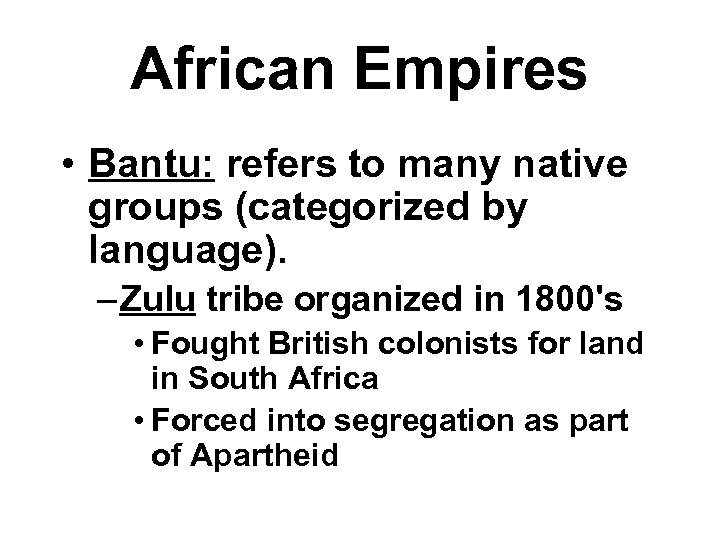 African Empires • Bantu: refers to many native groups (categorized by language). – Zulu tribe organized in 1800's • Fought British colonists for land in South Africa • Forced into segregation as part of Apartheid
African Empires • Bantu: refers to many native groups (categorized by language). – Zulu tribe organized in 1800's • Fought British colonists for land in South Africa • Forced into segregation as part of Apartheid

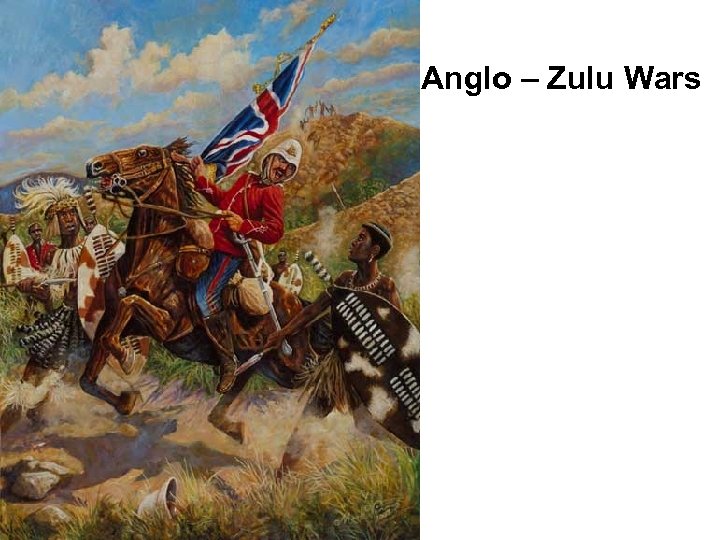 Anglo – Zulu Wars
Anglo – Zulu Wars
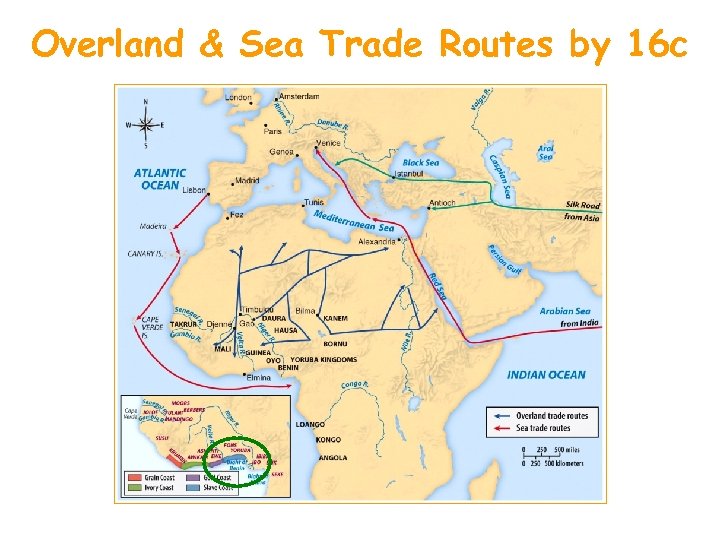 Overland & Sea Trade Routes by 16 c
Overland & Sea Trade Routes by 16 c

![African Trade [15 c-17 c] African Trade [15 c-17 c]](https://present5.com/presentation/aba463900c19a0fed60f21892d598faa/image-160.jpg) African Trade [15 c-17 c]
African Trade [15 c-17 c]
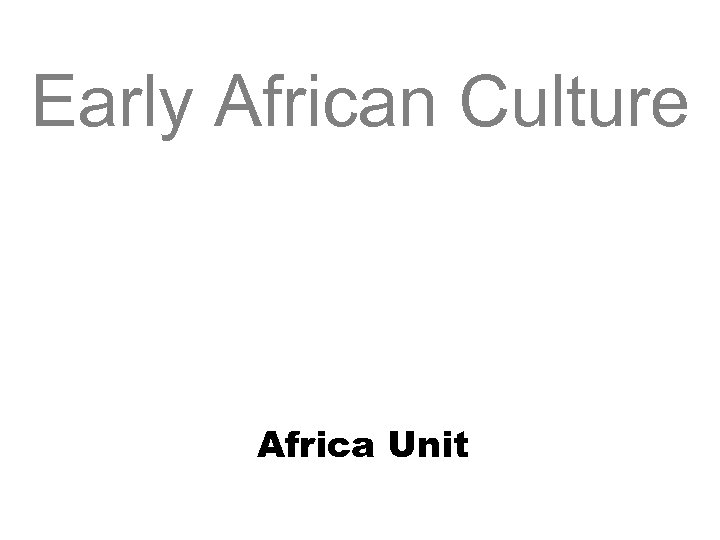 Early African Culture Africa Unit
Early African Culture Africa Unit
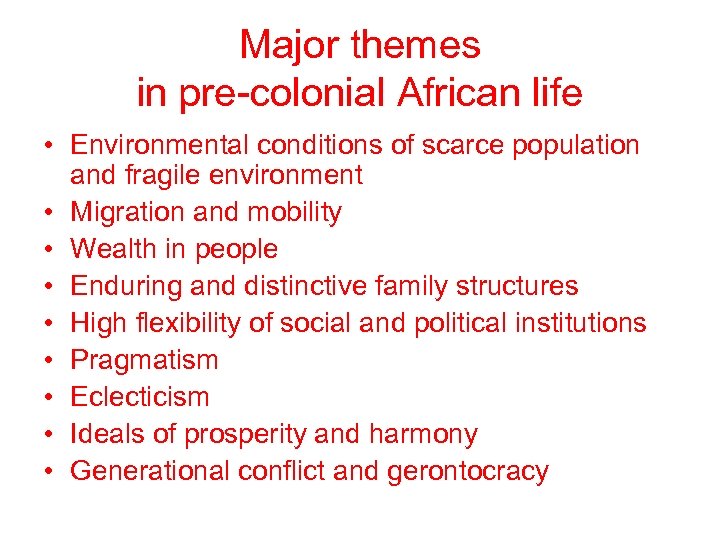 Major themes in pre-colonial African life • Environmental conditions of scarce population and fragile environment • Migration and mobility • Wealth in people • Enduring and distinctive family structures • High flexibility of social and political institutions • Pragmatism • Eclecticism • Ideals of prosperity and harmony • Generational conflict and gerontocracy
Major themes in pre-colonial African life • Environmental conditions of scarce population and fragile environment • Migration and mobility • Wealth in people • Enduring and distinctive family structures • High flexibility of social and political institutions • Pragmatism • Eclecticism • Ideals of prosperity and harmony • Generational conflict and gerontocracy
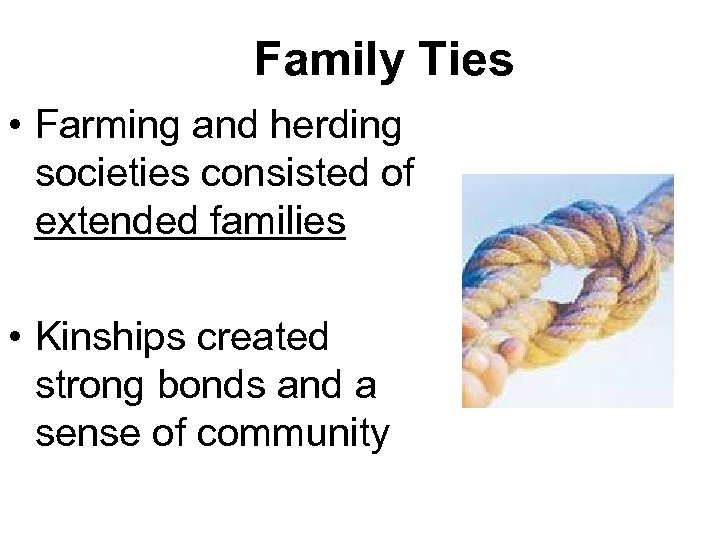 Family Ties • Farming and herding societies consisted of extended families • Kinships created strong bonds and a sense of community
Family Ties • Farming and herding societies consisted of extended families • Kinships created strong bonds and a sense of community
 Stateless Societies • Function of mobile population, underpopulation, and land as resource • Even when dense population, there was no state • Hunters valued over warriors • Ideal was the large complex household with Big Man surrounded by 10 -40 people • Control happened laterally, not hierarchically (secret societies, age-grade societies, ritual experts as mediators)
Stateless Societies • Function of mobile population, underpopulation, and land as resource • Even when dense population, there was no state • Hunters valued over warriors • Ideal was the large complex household with Big Man surrounded by 10 -40 people • Control happened laterally, not hierarchically (secret societies, age-grade societies, ritual experts as mediators)
 On your Left Side: • Draw the following pyramid on the next slide and add the information to the diagram.
On your Left Side: • Draw the following pyramid on the next slide and add the information to the diagram.
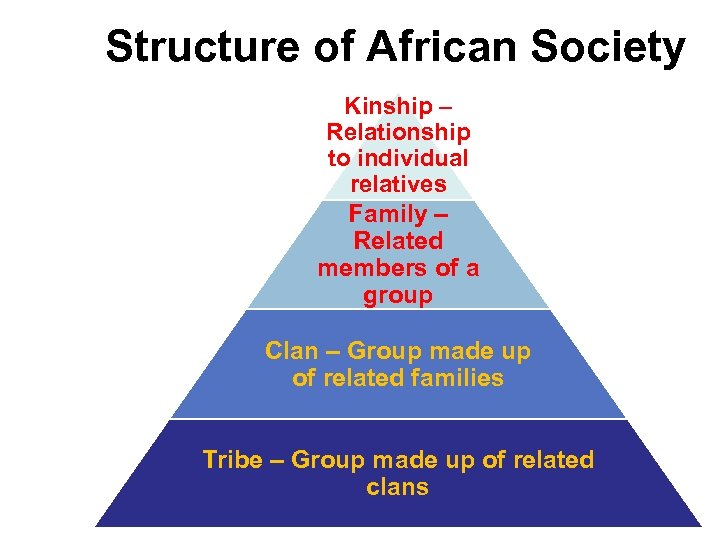 Structure of African Society Kinship – Relationship to individual relatives Family – Related members of a group Clan – Group made up of related families Tribe – Group made up of related clans
Structure of African Society Kinship – Relationship to individual relatives Family – Related members of a group Clan – Group made up of related families Tribe – Group made up of related clans

 Inheritance and Descent Matrilineal • The Ashanti people believed the child’s blood came entirely from the mother • Uncle is more important than the father Patrilineal • Oldest son is the head of the family • Oldest son was the inheritor
Inheritance and Descent Matrilineal • The Ashanti people believed the child’s blood came entirely from the mother • Uncle is more important than the father Patrilineal • Oldest son is the head of the family • Oldest son was the inheritor
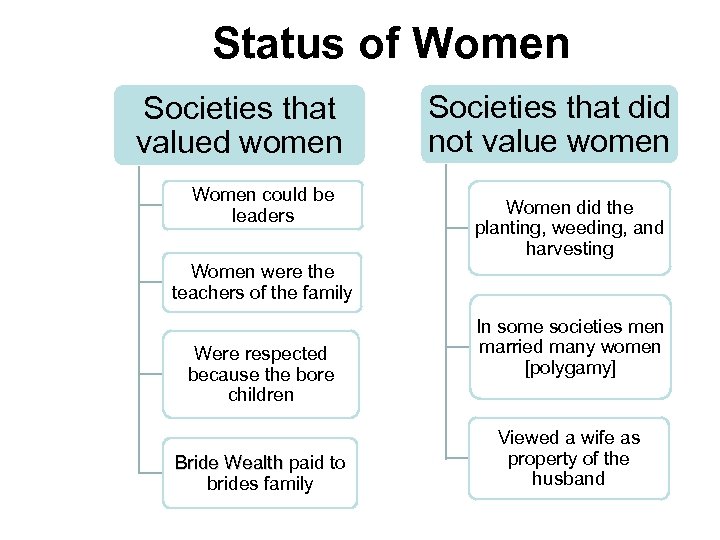 Status of Women Societies that valued women Women could be leaders Societies that did not value women Women did the planting, weeding, and harvesting Women were the teachers of the family Were respected because the bore children Bride Wealth paid to brides family In some societies men married many women [polygamy] Viewed a wife as property of the husband
Status of Women Societies that valued women Women could be leaders Societies that did not value women Women did the planting, weeding, and harvesting Women were the teachers of the family Were respected because the bore children Bride Wealth paid to brides family In some societies men married many women [polygamy] Viewed a wife as property of the husband
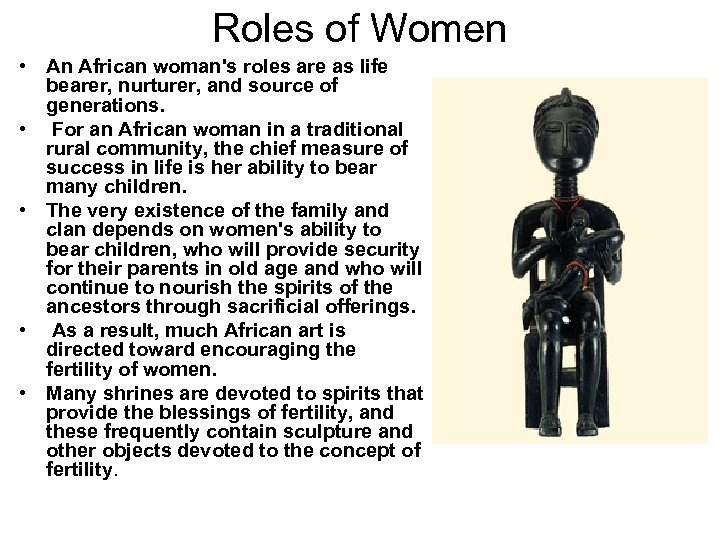 Roles of Women • An African woman's roles are as life bearer, nurturer, and source of generations. • For an African woman in a traditional rural community, the chief measure of success in life is her ability to bear many children. • The very existence of the family and clan depends on women's ability to bear children, who will provide security for their parents in old age and who will continue to nourish the spirits of the ancestors through sacrificial offerings. • As a result, much African art is directed toward encouraging the fertility of women. • Many shrines are devoted to spirits that provide the blessings of fertility, and these frequently contain sculpture and other objects devoted to the concept of fertility.
Roles of Women • An African woman's roles are as life bearer, nurturer, and source of generations. • For an African woman in a traditional rural community, the chief measure of success in life is her ability to bear many children. • The very existence of the family and clan depends on women's ability to bear children, who will provide security for their parents in old age and who will continue to nourish the spirits of the ancestors through sacrificial offerings. • As a result, much African art is directed toward encouraging the fertility of women. • Many shrines are devoted to spirits that provide the blessings of fertility, and these frequently contain sculpture and other objects devoted to the concept of fertility.
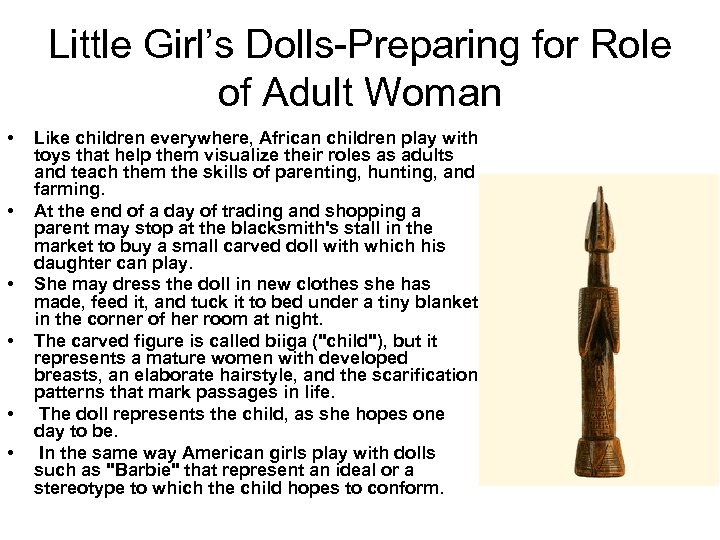 Little Girl’s Dolls-Preparing for Role of Adult Woman • • • Like children everywhere, African children play with toys that help them visualize their roles as adults and teach them the skills of parenting, hunting, and farming. At the end of a day of trading and shopping a parent may stop at the blacksmith's stall in the market to buy a small carved doll with which his daughter can play. She may dress the doll in new clothes she has made, feed it, and tuck it to bed under a tiny blanket in the corner of her room at night. The carved figure is called biiga ("child"), but it represents a mature women with developed breasts, an elaborate hairstyle, and the scarification patterns that mark passages in life. The doll represents the child, as she hopes one day to be. In the same way American girls play with dolls such as "Barbie" that represent an ideal or a stereotype to which the child hopes to conform.
Little Girl’s Dolls-Preparing for Role of Adult Woman • • • Like children everywhere, African children play with toys that help them visualize their roles as adults and teach them the skills of parenting, hunting, and farming. At the end of a day of trading and shopping a parent may stop at the blacksmith's stall in the market to buy a small carved doll with which his daughter can play. She may dress the doll in new clothes she has made, feed it, and tuck it to bed under a tiny blanket in the corner of her room at night. The carved figure is called biiga ("child"), but it represents a mature women with developed breasts, an elaborate hairstyle, and the scarification patterns that mark passages in life. The doll represents the child, as she hopes one day to be. In the same way American girls play with dolls such as "Barbie" that represent an ideal or a stereotype to which the child hopes to conform.
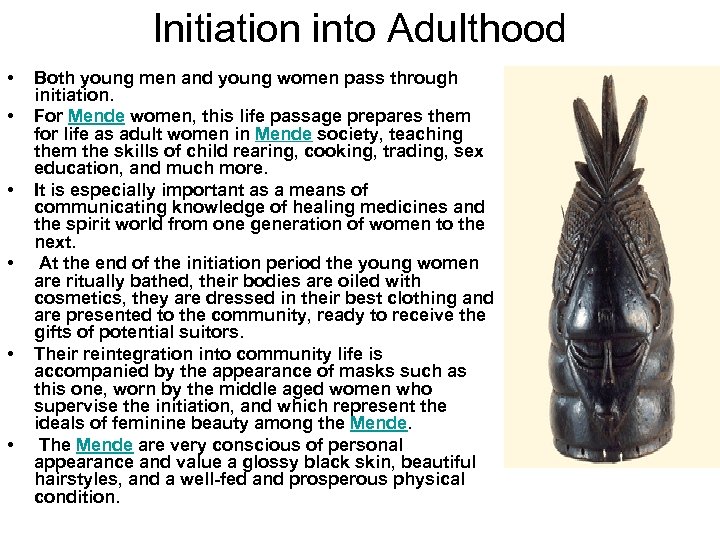 Initiation into Adulthood • • • Both young men and young women pass through initiation. For Mende women, this life passage prepares them for life as adult women in Mende society, teaching them the skills of child rearing, cooking, trading, sex education, and much more. It is especially important as a means of communicating knowledge of healing medicines and the spirit world from one generation of women to the next. At the end of the initiation period the young women are ritually bathed, their bodies are oiled with cosmetics, they are dressed in their best clothing and are presented to the community, ready to receive the gifts of potential suitors. Their reintegration into community life is accompanied by the appearance of masks such as this one, worn by the middle aged women who supervise the initiation, and which represent the ideals of feminine beauty among the Mende. The Mende are very conscious of personal appearance and value a glossy black skin, beautiful hairstyles, and a well-fed and prosperous physical condition.
Initiation into Adulthood • • • Both young men and young women pass through initiation. For Mende women, this life passage prepares them for life as adult women in Mende society, teaching them the skills of child rearing, cooking, trading, sex education, and much more. It is especially important as a means of communicating knowledge of healing medicines and the spirit world from one generation of women to the next. At the end of the initiation period the young women are ritually bathed, their bodies are oiled with cosmetics, they are dressed in their best clothing and are presented to the community, ready to receive the gifts of potential suitors. Their reintegration into community life is accompanied by the appearance of masks such as this one, worn by the middle aged women who supervise the initiation, and which represent the ideals of feminine beauty among the Mende. The Mende are very conscious of personal appearance and value a glossy black skin, beautiful hairstyles, and a well-fed and prosperous physical condition.
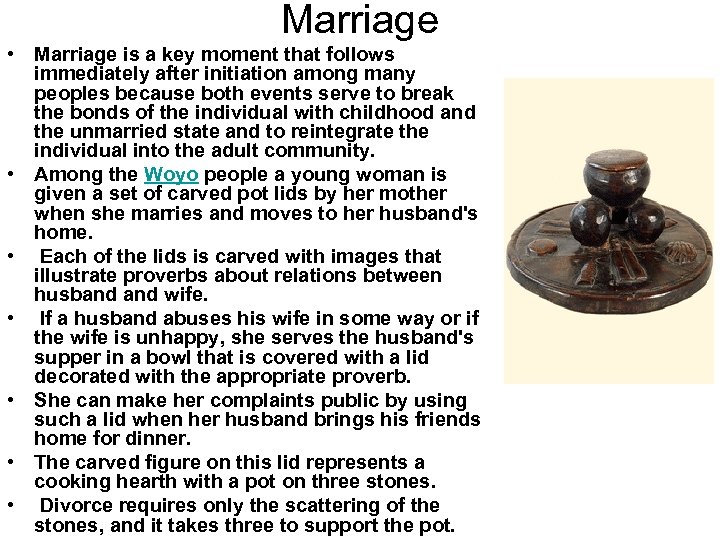 Marriage • Marriage is a key moment that follows immediately after initiation among many peoples because both events serve to break the bonds of the individual with childhood and the unmarried state and to reintegrate the individual into the adult community. • Among the Woyo people a young woman is given a set of carved pot lids by her mother when she marries and moves to her husband's home. • Each of the lids is carved with images that illustrate proverbs about relations between husband wife. • If a husband abuses his wife in some way or if the wife is unhappy, she serves the husband's supper in a bowl that is covered with a lid decorated with the appropriate proverb. • She can make her complaints public by using such a lid when her husband brings his friends home for dinner. • The carved figure on this lid represents a cooking hearth with a pot on three stones. • Divorce requires only the scattering of the stones, and it takes three to support the pot.
Marriage • Marriage is a key moment that follows immediately after initiation among many peoples because both events serve to break the bonds of the individual with childhood and the unmarried state and to reintegrate the individual into the adult community. • Among the Woyo people a young woman is given a set of carved pot lids by her mother when she marries and moves to her husband's home. • Each of the lids is carved with images that illustrate proverbs about relations between husband wife. • If a husband abuses his wife in some way or if the wife is unhappy, she serves the husband's supper in a bowl that is covered with a lid decorated with the appropriate proverb. • She can make her complaints public by using such a lid when her husband brings his friends home for dinner. • The carved figure on this lid represents a cooking hearth with a pot on three stones. • Divorce requires only the scattering of the stones, and it takes three to support the pot.
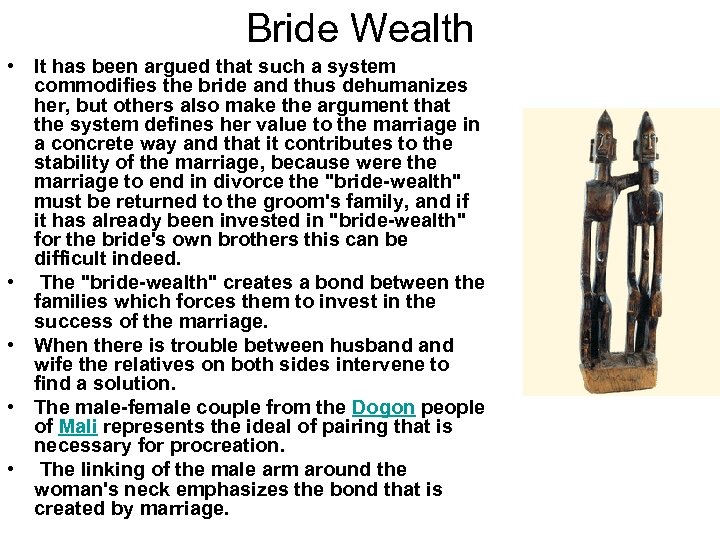 Bride Wealth • It has been argued that such a system commodifies the bride and thus dehumanizes her, but others also make the argument that the system defines her value to the marriage in a concrete way and that it contributes to the stability of the marriage, because were the marriage to end in divorce the "bride-wealth" must be returned to the groom's family, and if it has already been invested in "bride-wealth" for the bride's own brothers this can be difficult indeed. • The "bride-wealth" creates a bond between the families which forces them to invest in the success of the marriage. • When there is trouble between husband wife the relatives on both sides intervene to find a solution. • The male-female couple from the Dogon people of Mali represents the ideal of pairing that is necessary for procreation. • The linking of the male arm around the woman's neck emphasizes the bond that is created by marriage.
Bride Wealth • It has been argued that such a system commodifies the bride and thus dehumanizes her, but others also make the argument that the system defines her value to the marriage in a concrete way and that it contributes to the stability of the marriage, because were the marriage to end in divorce the "bride-wealth" must be returned to the groom's family, and if it has already been invested in "bride-wealth" for the bride's own brothers this can be difficult indeed. • The "bride-wealth" creates a bond between the families which forces them to invest in the success of the marriage. • When there is trouble between husband wife the relatives on both sides intervene to find a solution. • The male-female couple from the Dogon people of Mali represents the ideal of pairing that is necessary for procreation. • The linking of the male arm around the woman's neck emphasizes the bond that is created by marriage.
 Becoming a Parent • For an adult in Africa success in a traditional community is measured by his or her ability to find a partner, raise a family, and provide for the children that guarantee that the family will survive through the generations. • Every adult is beset by concerns about the health of her children, his ability to secure and hold a means to earn a living, about his own health and that of his partner, and about the many uncertainties that we must confront throughout our lives. • For a Baule man or woman to fail to marry, bear numerous children, and provide for his family is considered a serious problem. • She may visit a diviner who may prescribe the carving of a figure that represents the spouse s/he had in the spirit world before birth. • The spirit spouse takes possession of the figure, and care and attention as well as prayers and offerings are lavished on it to please it, so that it will permit its realworld spouse to fulfill his gender role. • This figure pair represents the female larger than the male, and so it may have belonged to a Baule man.
Becoming a Parent • For an adult in Africa success in a traditional community is measured by his or her ability to find a partner, raise a family, and provide for the children that guarantee that the family will survive through the generations. • Every adult is beset by concerns about the health of her children, his ability to secure and hold a means to earn a living, about his own health and that of his partner, and about the many uncertainties that we must confront throughout our lives. • For a Baule man or woman to fail to marry, bear numerous children, and provide for his family is considered a serious problem. • She may visit a diviner who may prescribe the carving of a figure that represents the spouse s/he had in the spirit world before birth. • The spirit spouse takes possession of the figure, and care and attention as well as prayers and offerings are lavished on it to please it, so that it will permit its realworld spouse to fulfill his gender role. • This figure pair represents the female larger than the male, and so it may have belonged to a Baule man.
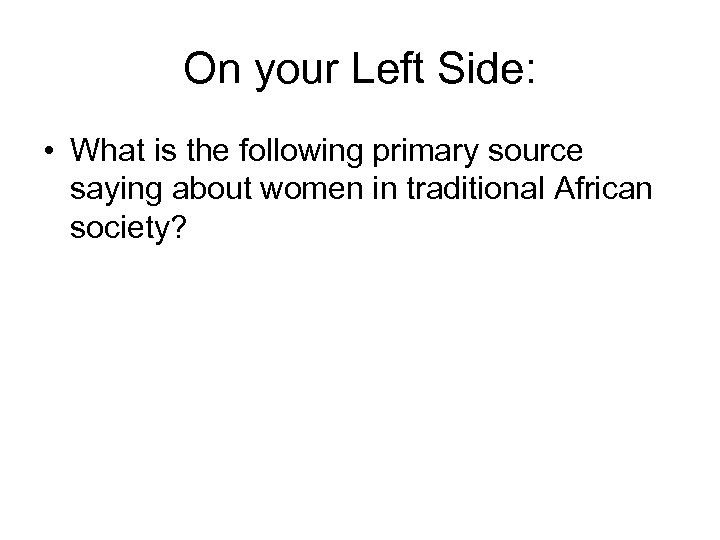 On your Left Side: • What is the following primary source saying about women in traditional African society?
On your Left Side: • What is the following primary source saying about women in traditional African society?
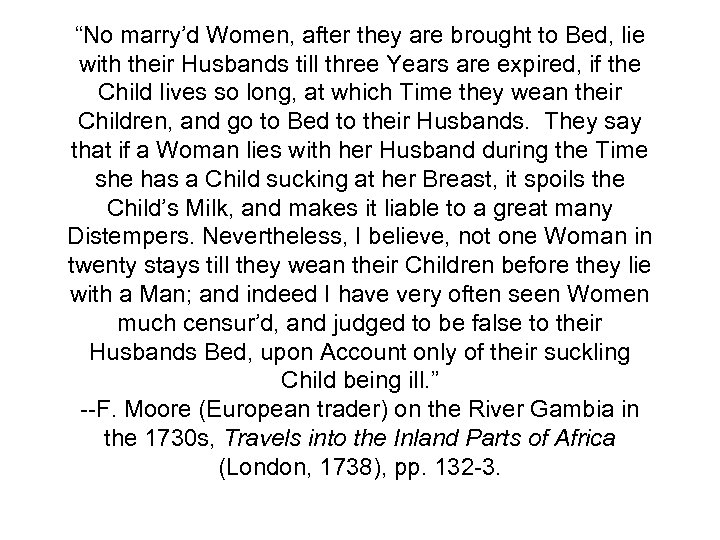 “No marry’d Women, after they are brought to Bed, lie with their Husbands till three Years are expired, if the Child lives so long, at which Time they wean their Children, and go to Bed to their Husbands. They say that if a Woman lies with her Husband during the Time she has a Child sucking at her Breast, it spoils the Child’s Milk, and makes it liable to a great many Distempers. Nevertheless, I believe, not one Woman in twenty stays till they wean their Children before they lie with a Man; and indeed I have very often seen Women much censur’d, and judged to be false to their Husbands Bed, upon Account only of their suckling Child being ill. ” --F. Moore (European trader) on the River Gambia in the 1730 s, Travels into the Inland Parts of Africa (London, 1738), pp. 132 -3.
“No marry’d Women, after they are brought to Bed, lie with their Husbands till three Years are expired, if the Child lives so long, at which Time they wean their Children, and go to Bed to their Husbands. They say that if a Woman lies with her Husband during the Time she has a Child sucking at her Breast, it spoils the Child’s Milk, and makes it liable to a great many Distempers. Nevertheless, I believe, not one Woman in twenty stays till they wean their Children before they lie with a Man; and indeed I have very often seen Women much censur’d, and judged to be false to their Husbands Bed, upon Account only of their suckling Child being ill. ” --F. Moore (European trader) on the River Gambia in the 1730 s, Travels into the Inland Parts of Africa (London, 1738), pp. 132 -3.
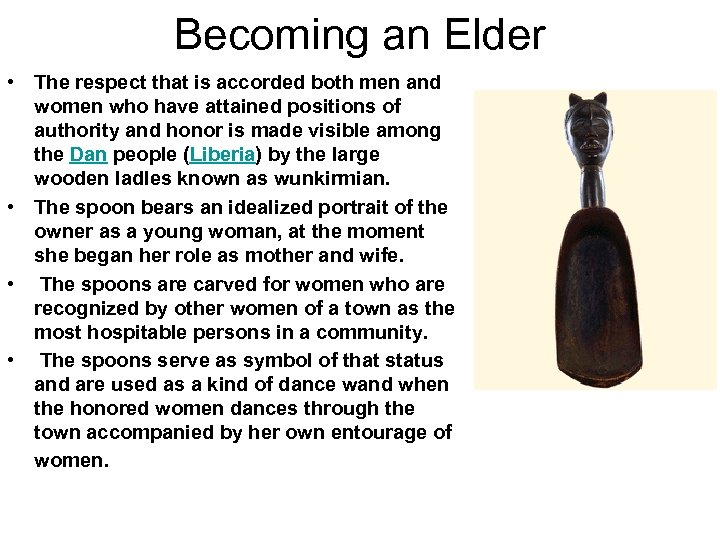 Becoming an Elder • The respect that is accorded both men and women who have attained positions of authority and honor is made visible among the Dan people (Liberia) by the large wooden ladles known as wunkirmian. • The spoon bears an idealized portrait of the owner as a young woman, at the moment she began her role as mother and wife. • The spoons are carved for women who are recognized by other women of a town as the most hospitable persons in a community. • The spoons serve as symbol of that status and are used as a kind of dance wand when the honored women dances through the town accompanied by her own entourage of women.
Becoming an Elder • The respect that is accorded both men and women who have attained positions of authority and honor is made visible among the Dan people (Liberia) by the large wooden ladles known as wunkirmian. • The spoon bears an idealized portrait of the owner as a young woman, at the moment she began her role as mother and wife. • The spoons are carved for women who are recognized by other women of a town as the most hospitable persons in a community. • The spoons serve as symbol of that status and are used as a kind of dance wand when the honored women dances through the town accompanied by her own entourage of women.
 Patterns of Government Local leaders are chosen Leaders listen to arguments Problem arises Public Discussion Consensus is reached Gifts exchanged
Patterns of Government Local leaders are chosen Leaders listen to arguments Problem arises Public Discussion Consensus is reached Gifts exchanged
 Economic Organization • Most villagers were subsistence farmers – They produced only enough food for their own needs with little or no surplus • Fallow – allowing the land to regenerate important minerals needed to grow crops • Land was community property
Economic Organization • Most villagers were subsistence farmers – They produced only enough food for their own needs with little or no surplus • Fallow – allowing the land to regenerate important minerals needed to grow crops • Land was community property
![Natural Resources [water / land] Human Resources [labor / knowledge] Subsistence Farming Capital Resources Natural Resources [water / land] Human Resources [labor / knowledge] Subsistence Farming Capital Resources](https://present5.com/presentation/aba463900c19a0fed60f21892d598faa/image-181.jpg) Natural Resources [water / land] Human Resources [labor / knowledge] Subsistence Farming Capital Resources [seed / tools] Distribution [family / friends]
Natural Resources [water / land] Human Resources [labor / knowledge] Subsistence Farming Capital Resources [seed / tools] Distribution [family / friends]
 The Age Grade System Definition Purpose Effect • Includes all boys or girls born in the same year • This same age group works together for their entire lives • To Learn about community and shared duties • Together they take part in special age ceremonies • This group usually thinks similarly and works together quite well
The Age Grade System Definition Purpose Effect • Includes all boys or girls born in the same year • This same age group works together for their entire lives • To Learn about community and shared duties • Together they take part in special age ceremonies • This group usually thinks similarly and works together quite well
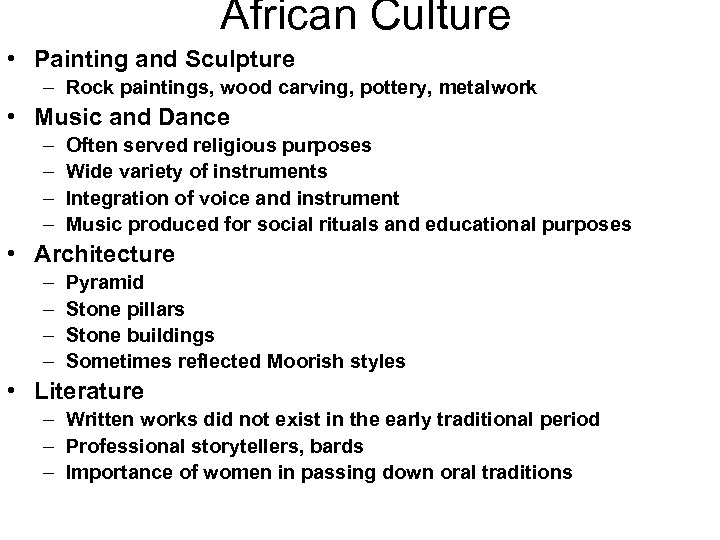 African Culture • Painting and Sculpture – Rock paintings, wood carving, pottery, metalwork • Music and Dance – – Often served religious purposes Wide variety of instruments Integration of voice and instrument Music produced for social rituals and educational purposes • Architecture – – Pyramid Stone pillars Stone buildings Sometimes reflected Moorish styles • Literature – Written works did not exist in the early traditional period – Professional storytellers, bards – Importance of women in passing down oral traditions
African Culture • Painting and Sculpture – Rock paintings, wood carving, pottery, metalwork • Music and Dance – – Often served religious purposes Wide variety of instruments Integration of voice and instrument Music produced for social rituals and educational purposes • Architecture – – Pyramid Stone pillars Stone buildings Sometimes reflected Moorish styles • Literature – Written works did not exist in the early traditional period – Professional storytellers, bards – Importance of women in passing down oral traditions
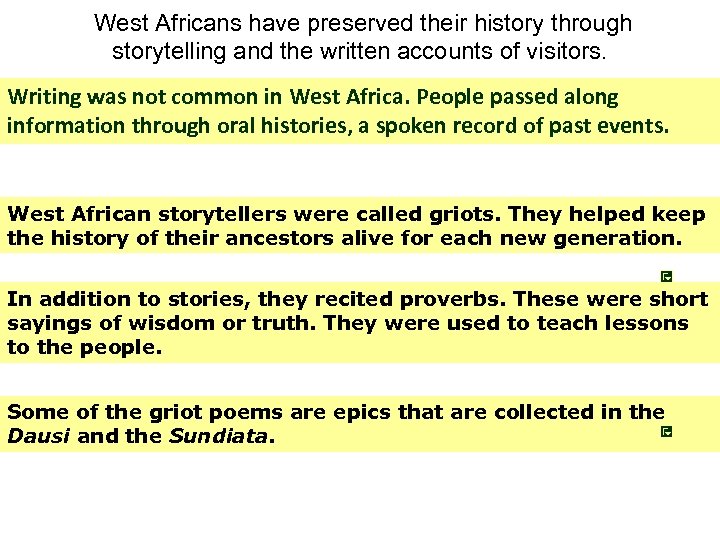 West Africans have preserved their history through storytelling and the written accounts of visitors. Writing was not common in West Africa. People passed along information through oral histories, a spoken record of past events. West African storytellers were called griots. They helped keep the history of their ancestors alive for each new generation. In addition to stories, they recited proverbs. These were short sayings of wisdom or truth. They were used to teach lessons to the people. Some of the griot poems are epics that are collected in the Dausi and the Sundiata.
West Africans have preserved their history through storytelling and the written accounts of visitors. Writing was not common in West Africa. People passed along information through oral histories, a spoken record of past events. West African storytellers were called griots. They helped keep the history of their ancestors alive for each new generation. In addition to stories, they recited proverbs. These were short sayings of wisdom or truth. They were used to teach lessons to the people. Some of the griot poems are epics that are collected in the Dausi and the Sundiata.
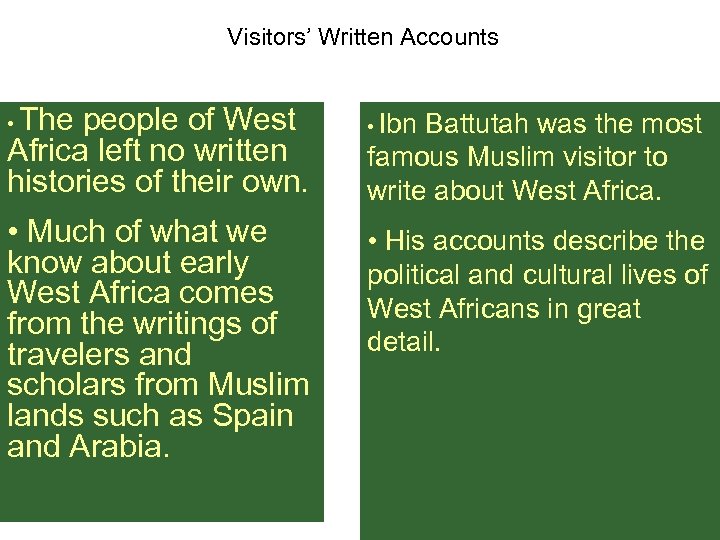 Visitors’ Written Accounts The people of West Africa left no written histories of their own. • • Much of what we know about early West Africa comes from the writings of travelers and scholars from Muslim lands such as Spain and Arabia. • Ibn Battutah was the most famous Muslim visitor to write about West Africa. • His accounts describe the political and cultural lives of West Africans in great detail.
Visitors’ Written Accounts The people of West Africa left no written histories of their own. • • Much of what we know about early West Africa comes from the writings of travelers and scholars from Muslim lands such as Spain and Arabia. • Ibn Battutah was the most famous Muslim visitor to write about West Africa. • His accounts describe the political and cultural lives of West Africans in great detail.
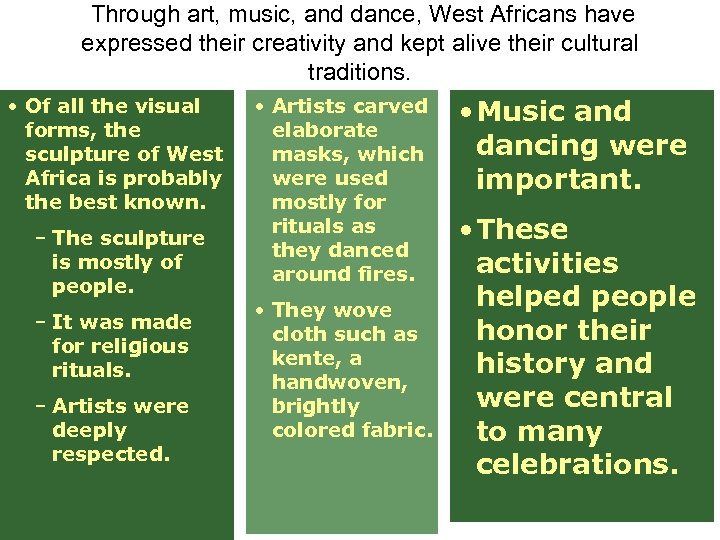 Through art, music, and dance, West Africans have expressed their creativity and kept alive their cultural traditions. • Of all the visual forms, the sculpture of West Africa is probably the best known. – The sculpture is mostly of people. – It was made for religious rituals. – Artists were deeply respected. • Artists carved elaborate masks, which were used mostly for rituals as they danced around fires. • They wove cloth such as kente, a handwoven, brightly colored fabric. • Music and dancing were important. • These activities helped people honor their history and were central to many celebrations.
Through art, music, and dance, West Africans have expressed their creativity and kept alive their cultural traditions. • Of all the visual forms, the sculpture of West Africa is probably the best known. – The sculpture is mostly of people. – It was made for religious rituals. – Artists were deeply respected. • Artists carved elaborate masks, which were used mostly for rituals as they danced around fires. • They wove cloth such as kente, a handwoven, brightly colored fabric. • Music and dancing were important. • These activities helped people honor their history and were central to many celebrations.
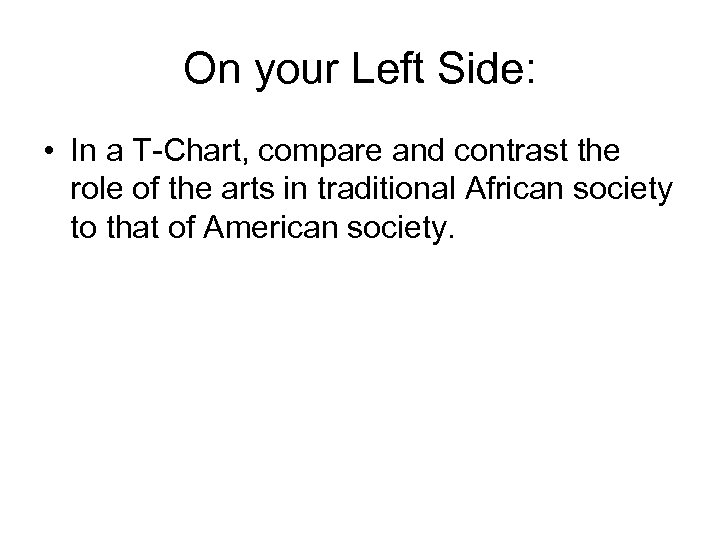 On your Left Side: • In a T-Chart, compare and contrast the role of the arts in traditional African society to that of American society.
On your Left Side: • In a T-Chart, compare and contrast the role of the arts in traditional African society to that of American society.
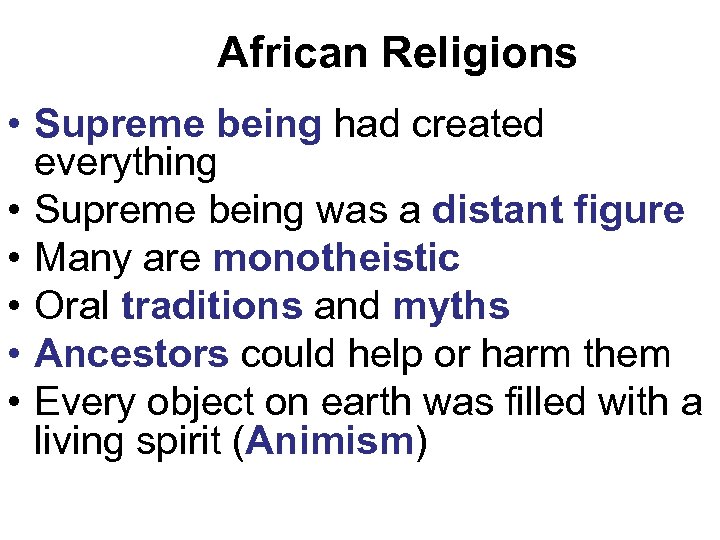 African Religions • Supreme being had created everything • Supreme being was a distant figure • Many are monotheistic • Oral traditions and myths • Ancestors could help or harm them • Every object on earth was filled with a living spirit (Animism)
African Religions • Supreme being had created everything • Supreme being was a distant figure • Many are monotheistic • Oral traditions and myths • Ancestors could help or harm them • Every object on earth was filled with a living spirit (Animism)
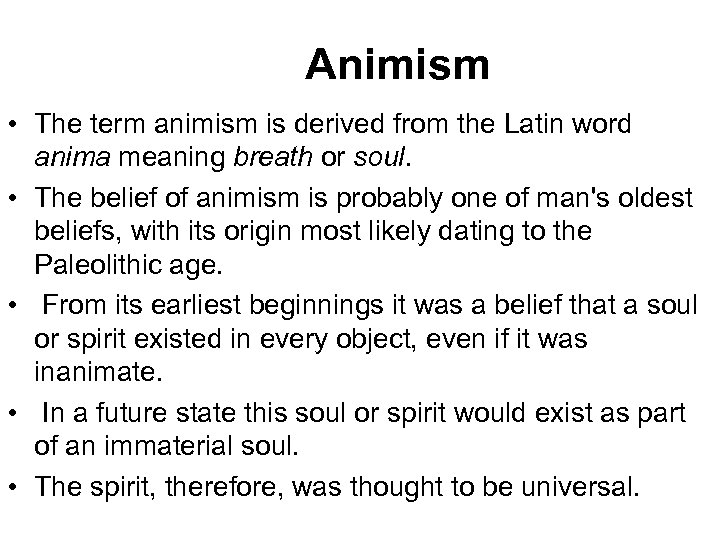 Animism • The term animism is derived from the Latin word anima meaning breath or soul. • The belief of animism is probably one of man's oldest beliefs, with its origin most likely dating to the Paleolithic age. • From its earliest beginnings it was a belief that a soul or spirit existed in every object, even if it was inanimate. • In a future state this soul or spirit would exist as part of an immaterial soul. • The spirit, therefore, was thought to be universal.
Animism • The term animism is derived from the Latin word anima meaning breath or soul. • The belief of animism is probably one of man's oldest beliefs, with its origin most likely dating to the Paleolithic age. • From its earliest beginnings it was a belief that a soul or spirit existed in every object, even if it was inanimate. • In a future state this soul or spirit would exist as part of an immaterial soul. • The spirit, therefore, was thought to be universal.
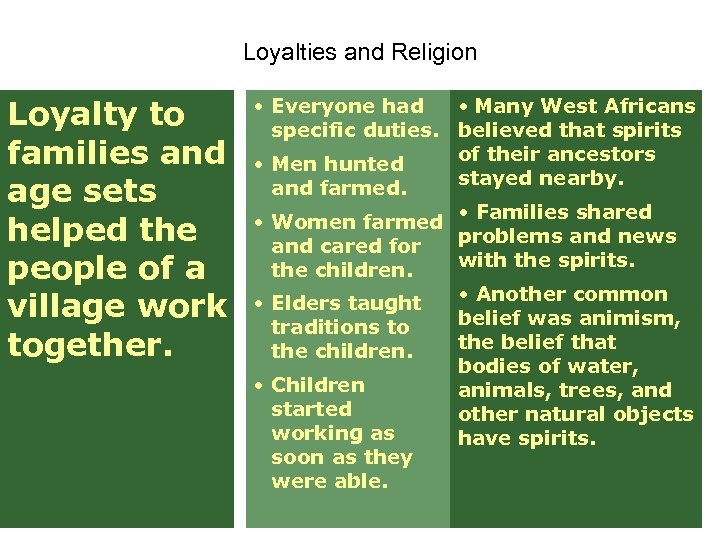 Loyalties and Religion Loyalty to families and age sets helped the people of a village work together. • Everyone had • Many West Africans specific duties. believed that spirits of their ancestors • Men hunted stayed nearby. and farmed. • Women farmed • Families shared problems and news and cared for with the spirits. the children. • Another common • Elders taught belief was animism, traditions to the belief that the children. bodies of water, • Children animals, trees, and started other natural objects working as have spirits. soon as they were able.
Loyalties and Religion Loyalty to families and age sets helped the people of a village work together. • Everyone had • Many West Africans specific duties. believed that spirits of their ancestors • Men hunted stayed nearby. and farmed. • Women farmed • Families shared problems and news and cared for with the spirits. the children. • Another common • Elders taught belief was animism, traditions to the belief that the children. bodies of water, • Children animals, trees, and started other natural objects working as have spirits. soon as they were able.
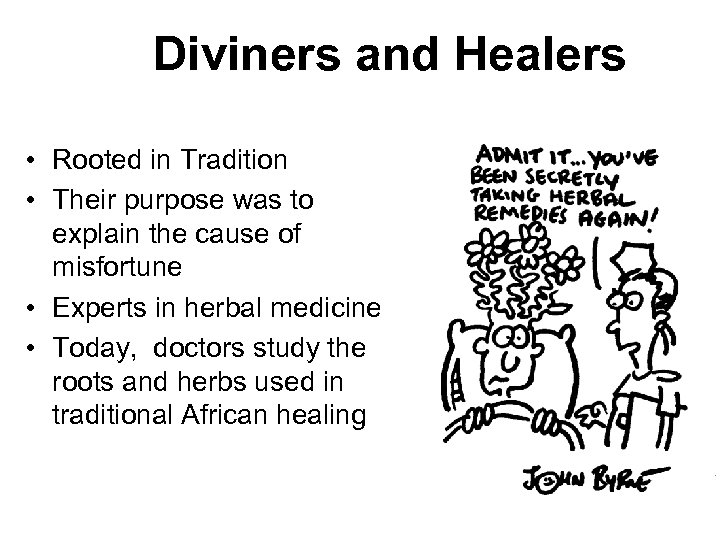 Diviners and Healers • Rooted in Tradition • Their purpose was to explain the cause of misfortune • Experts in herbal medicine • Today, doctors study the roots and herbs used in traditional African healing
Diviners and Healers • Rooted in Tradition • Their purpose was to explain the cause of misfortune • Experts in herbal medicine • Today, doctors study the roots and herbs used in traditional African healing
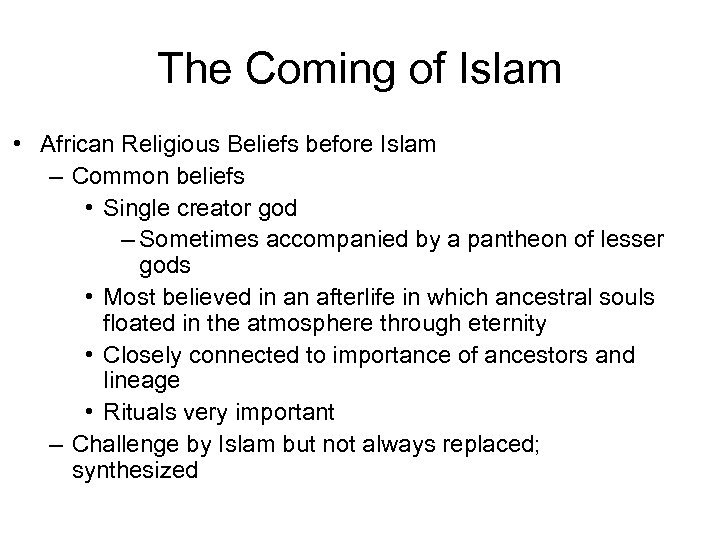 The Coming of Islam • African Religious Beliefs before Islam – Common beliefs • Single creator god – Sometimes accompanied by a pantheon of lesser gods • Most believed in an afterlife in which ancestral souls floated in the atmosphere through eternity • Closely connected to importance of ancestors and lineage • Rituals very important – Challenge by Islam but not always replaced; synthesized
The Coming of Islam • African Religious Beliefs before Islam – Common beliefs • Single creator god – Sometimes accompanied by a pantheon of lesser gods • Most believed in an afterlife in which ancestral souls floated in the atmosphere through eternity • Closely connected to importance of ancestors and lineage • Rituals very important – Challenge by Islam but not always replaced; synthesized
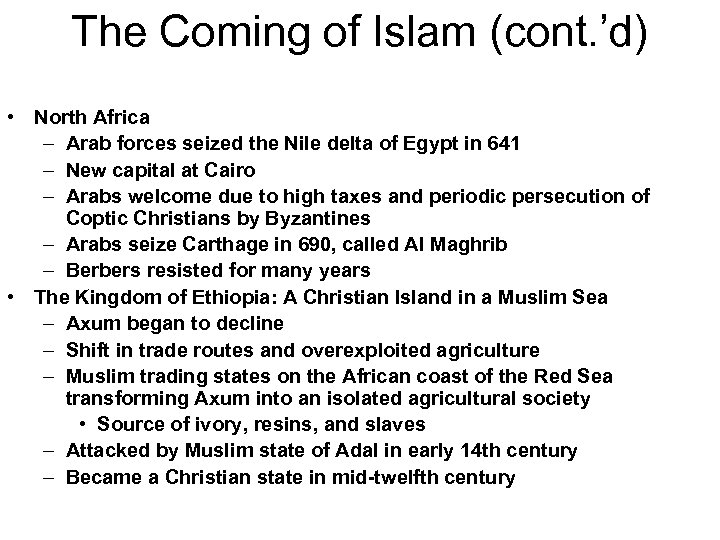 The Coming of Islam (cont. ’d) • North Africa – Arab forces seized the Nile delta of Egypt in 641 – New capital at Cairo – Arabs welcome due to high taxes and periodic persecution of Coptic Christians by Byzantines – Arabs seize Carthage in 690, called Al Maghrib – Berbers resisted for many years • The Kingdom of Ethiopia: A Christian Island in a Muslim Sea – Axum began to decline – Shift in trade routes and overexploited agriculture – Muslim trading states on the African coast of the Red Sea transforming Axum into an isolated agricultural society • Source of ivory, resins, and slaves – Attacked by Muslim state of Adal in early 14 th century – Became a Christian state in mid-twelfth century
The Coming of Islam (cont. ’d) • North Africa – Arab forces seized the Nile delta of Egypt in 641 – New capital at Cairo – Arabs welcome due to high taxes and periodic persecution of Coptic Christians by Byzantines – Arabs seize Carthage in 690, called Al Maghrib – Berbers resisted for many years • The Kingdom of Ethiopia: A Christian Island in a Muslim Sea – Axum began to decline – Shift in trade routes and overexploited agriculture – Muslim trading states on the African coast of the Red Sea transforming Axum into an isolated agricultural society • Source of ivory, resins, and slaves – Attacked by Muslim state of Adal in early 14 th century – Became a Christian state in mid-twelfth century
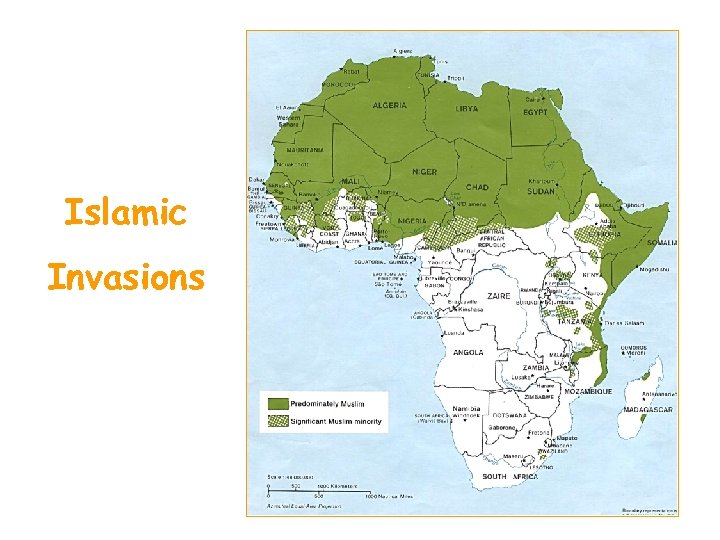 Islamic Invasions
Islamic Invasions


